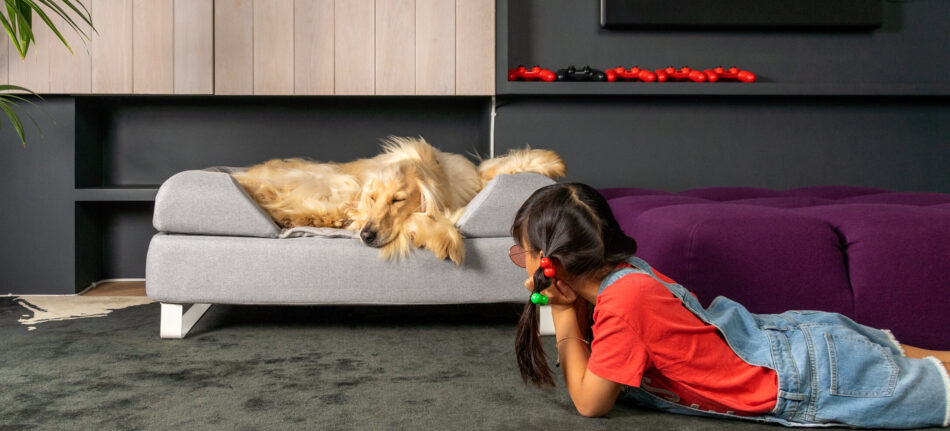
Washing a dog bed regularly can help to ensure your pet always has a clean environment. It also minimizes the risk of fleas, germs, and dirt build up. Our guide shows you how to easily wash your dog’s bed, as well as the best beds to keep your dog happy and healthy.
Why do dog beds need washing?
An unclean dog bed can cause serious problems for your beloved pet. Infections can be passed from dog poo and urine or anything the dog has regurgitated. The bacteria in these bodily discharges can linger in the mattress for several months. There are potential problems with an unwashed dog bed that a simple brush or vacuum-clean cannot tackle. Sleeping in this unsanitary condition could result in your dog becoming ill, with the knowledge to keep their dog bed clean you’ll be able to reduce this risk.
All dog beds provide a good night’s sleep for your dog, but the best ones do far more than that. They keep dirt and bacteria at bay and make the home environment healthier for everyone.
Dog beds become dirty and smelly over time. They can also harbor flea eggs or ticks. Washing them is essential, and this can be a simple or complicated task, depending on the type of dog bed your pet has.
Washing a dog bed with a removable cover is simple. Without a removable cover, a thorough clean becomes more challenging.
Simple steps to wash a dog bed with removable covers
Washable dog beds with a cover are easier to clean than ones without a cover. Our easy steps on how to clean a dog bed with removable covers will help you give your pet a sparkling bed in no time.
How to wash the dog bed cover
- Vacuum the dust and hair from the dog bed and dog blanket to prevent the fine hairs from clogging up your washing machine filter. A vacuum cleaner with an upholstery attachment is ideal.
- Remove the cover and vacuum the mattress and all other parts of the bed.
- The cover of the dog bed can then be washed, along with the blanket. Use a pet-safe washing liquid and, if needed, a stain remover.
Washing your dog’s mattress
Depending on the type of bed you have, you will sometimes have to wash the mattress of your dog bed too. A model like the Topology dog bed has a waterproof cover that keeps the dirt away from the mattress. Although there may be occasional leaks if the dog has soiled the bed, in which case the mattress will need washing.
- The dog bed mattress should be soaked in a bathtub of hot water using a pet-safe washing product.
- Alternatively, it can be soaked for 15 minutes in a tub of water in which two tablespoons of bicarbonate of soda have been dissolved.
- Some mattresses are pliable enough to be washed in a washing machine and dried in a tumble dryer.
- Otherwise, it will have to dry outside. Choose a warm sunny day if possible – easier said than done at certain times of the year! The important detail is to choose a well-ventilated area, which will prevent mold from growing as the bed dries.
Washing a dog bed without a cover
Even if your dog bed does not have a removable cover, you can still wash it with ease. The following steps detail how to hand wash your dog bed.
- First, vacuum-clean the bed, getting into all the folds and corners.
- Next, use a brush to loosen any hairs caught in the dog bed’s fabric and then vacuum it again.
- Individual stains can be spot-treated with an enzyme-based cleaner before soaking the whole bed in hot soapy water for 15 minutes. Squeeze and turn the bed a few times during this time, to remove as much dirt as possible.
- If the bed is very dirty and the water turns brown, soak the bed for five minutes and then replace the water.
- The bed should then be scrubbed all over using a damp brush dipped in baking soda. Use a toothbrush for the folds, seams and corners. This will add the finishing touches to the cleaning and will also deodorize the dog bed.
- Fill the tub with warm water again and soak the dog bed, squeezing and kneading it to remove all traces of detergent.
- Repeat until the water shows no traces of soap bubbles.
- The dog bed can then be air-dried in a warm and well-ventilated place.
Omlet’s easy to clean dog bed
The perfect easy to wash dog bed is a waterproof one made with cleaning in mind. If it has a machine washable cover that zips on, the bed can be washed and dried within a few hours. This system also has the advantage of longevity, as a worn-out cover can be replaced.
Our Topology dog beds employ this system and come in various versions and colors, all machine-washable at 30C (85F). You’ll also find the Omlet Bolster Dog Beds have removable covers for easy washing too. By matching light and dark colors to your dog’s coat, the hair will be less visible. A minor issue, perhaps, but white hair on a dark mattress, or dark hair on a white bed, looks very messy. The Topology covers are also waterproof, which protects the memory-foam mattress underneath. They come in different sizes, too, to suit all breeds of dog. Topology beds also prevent dirt from accumulating around the bed or mattress, as they have frames with legs that keep the structure off the ground.
How often to wash a dog bed
Now you know how to wash your dog’s bed, you may wonder how often you should be cleaning it. Washing the dog bed cover once every week or so eliminates issues of dirt and germ build up. The frequency will depend largely on how much hair the dog sheds and how dirty it tends to get. If anyone in the household has a dog allergy, frequent cleaning is essential.
To kill any potential nasties lurking in the bedding, it will ideally need to be washed at 60C (140F). Although lots of dog bedding will have washing instructions recommending a lower temperature. A waterproof cover, which is a feature of the Topology range, prevents the mattress from soiling, and these covers can be washed at low temperatures.
Omlet petcare
Treat your dog to the accessories they deserve. Luxury dog crates that will help to crate train puppies as well as training adult dogs, to dog toys that will help build your bond, we have the items to make your dog comfy and happy.
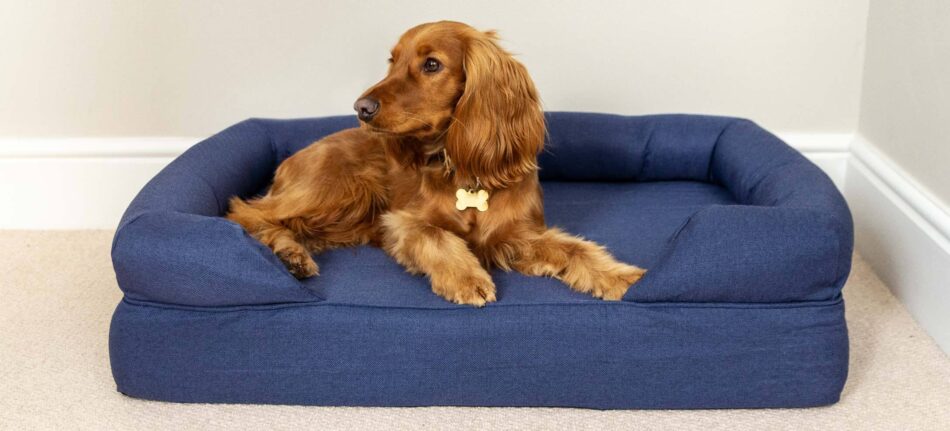
This entry was posted in Dogs
So you’ve decided to add a new member to your fur family – congratulations! While you are preparing for all the ways you can make the new puppy comfortable at your home, it’s equally important to prepare for the introduction of your new pup to your resident dog. You know, the one who has held the title of “only dog in the house” forever?!
Dogs are innately social animals, but that doesn’t mean they all get along at first sniff. Taking the time to prepare for a puppy homecoming and the new adjustments will help make this transition easier and enjoyable. Here are some ways to be certain that every pet feels at ease when you bring home a new puppy.
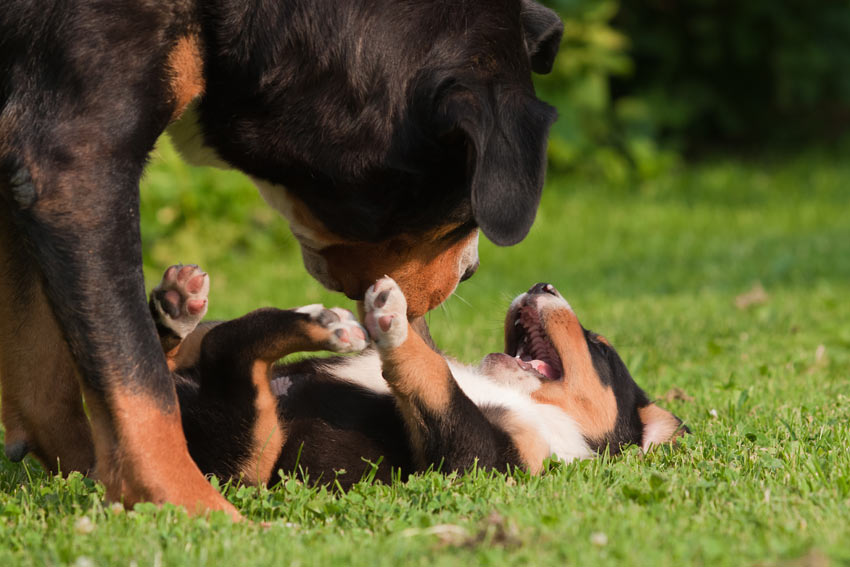
Preparation
In the last few years, many pet owners have adjusted their work schedules to include increased flexibility and working more from home. And with more time spent at home, it’s been the paw-fect opportunity to introduce a new puppy to the family! But what about the furry friends that are already part of your family? How do you know if they want a new friend, too? And what should you do before you actually bring your new pint-sized pal home?
The key to any great success is preparation! When it comes to introducing a new puppy to your resident dog, that is no different. Your current dog has become accustomed to certain routines. They eat in certain places, sleep in specific spots, and have at least one (or seven!) favorite dog toys. Prior to bringing home a new pup, it’s best to separate your resident dog’s “stuff” in one area so it is safe and secure away from the new dog’s area. Even if your reliable resident rover has never shown aggression before, this is a cautious approach for the first few weeks to prevent your current dog from becoming territorial of their toys and spaces.
On top of all the other puppy essentials you will need for the new arrival, this is also a good time to set up gates or dog crates to separate spaces. This will provide two benefits: making sure your new puppy does not feel overwhelmed with access to the whole house and comforting your resident dog who already has their favorite spots to snooze, lounge, and play. Plus, your resident dog may just need a break from all that puppy energy!
The first meet
The humans in your family have met the new puppy, but now it’s time to introduce your resident dog to the new fur member! Here are some tips on how to have a paws-itive first meeting:
- Locate a neutral spot for first introductions. Neither dog should feel territorial to the meeting place so pick somewhere that is away from your house for first sniffs. And since most puppies have to wait until 12 weeks of age to receive all of their shots before safely being around other dogs, try and avoid areas with lots of other pups running around.
- Allow both dogs to meet naturally like dogs do! Sniffs, whiffs, and even ignoring one another can be expected – and allowed! – on their first meeting.
- Try to keep the initial introductions brief and then head out on a walk with both dogs. This will allow their interactions to continue while also being distracted by other sights and smells.
- Before heading back inside, allow some additional play between the two dogs in the front or backyard of your house. This will allow you to see how your resident dog feels about having a new playmate on their ‘territory’.
- Once everyone has expended some energy, it’s time to bring the paw-ty back inside to continue to get to know one another!
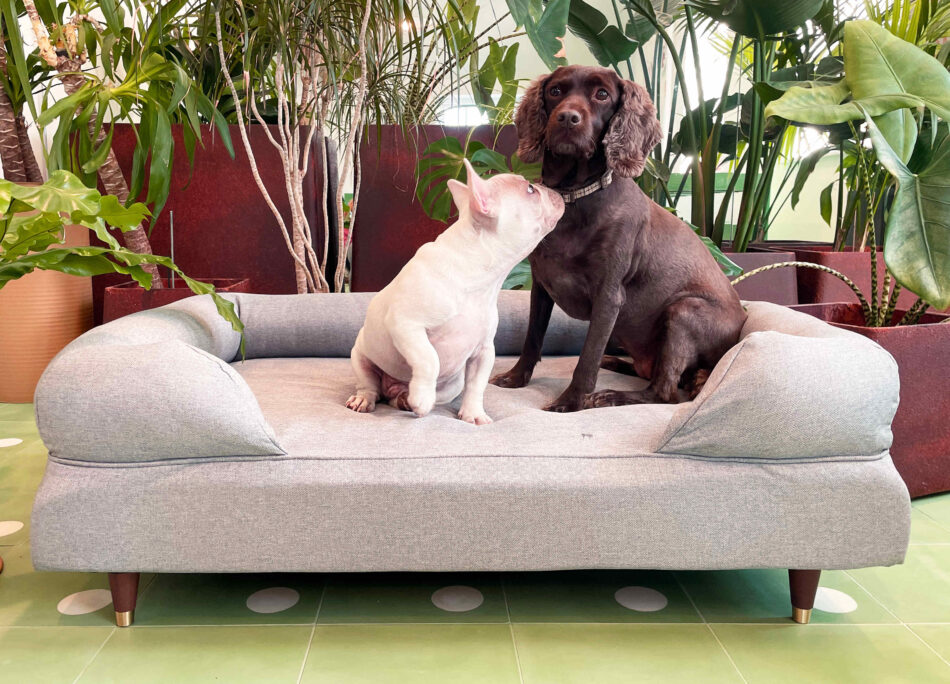
The first few weeks
Now that everyone is getting acquainted and settled in, you want to start to establish new routines. For the first few weeks after the new puppy comes home, it is best to feed your resident dog in a separate area. Puppies need to eat specific food that helps them to grow big and strong! So make sure your bigger dog eats separately to avoid any urges in helping themselves to the puppy food buffet!
Also, keep an eye out for any sudden changes in behavior from your older dog. Remember, they lived here first so adjustments to the new member of the fur family may take some time. Patience is key!
The goal to work towards after the first few weeks is to slowly get all four-legged friends living cohesively together. Slowly move bowls and beds closer to each other and keep engaging group play and walks to encourage the inevitable bonds. Before long, you and your resident dog will wonder how you ever lived without the puppy in the first place!
5 essential new puppy products
Just like human babies, new puppies require a lot of “stuff” to make your home, their home. Here is a list of new puppy must-haves to make the homecoming transition seamless:
Dog Crate
While some pet owners might worry about putting their precious new puppies in a crate, there are actually many benefits of an enclosed space that your dog craves! Dogs are denning animals so they naturally seek out small, secluded spaces as a way of feeling safe and protected. Most veterinarians recommend crate training your puppy as an essential way of housetraining and keeping your new dog safe. Having a crate for your puppy will also help the transition with your resident dog who already has a chosen safety spot! The Omlet Fido Nook Dog Crate is a great option as it combines a modern look with a cozy place for your puppy to call its’ own!
Dog Bed
You likely already have a dog bed (or three!) for your dog, but don’t forget to have one for your new puppy, too! Dogs like to have a space that is their own and with as much as puppies like to sleep, it’s important that space is comfortable! Because puppies are still small in stature, be sure to get a bed that is not elevated so it’s easier to climb in and out. And don’t forget to find a bed that is durable and washable as puppies are still learning the ropes when it comes to potty training!
Dog Toys
If you have ever had a puppy you know all too well how sharp those tiny puppy teeth can be! When bringing a new puppy into your fur family, it’s important that you have new dog toys that are not part of your resident dog’s collection. Ensuring each pup has their own set of squeekers and chews will help reduce any issues!
Dog Treats
Rewards with food are what any dog lives for! Puppies will need lots of training in the first few months, so having mini dog-friendly treats on hand will reinforce those good learned behaviors. After they obey a command or do potty outside, give the new puppy a treat to show them they did a good job! Your resident dog can also get treats for showing good behavior with the new pup. Just remember that good behavior has to be rewarded right when it happens in order to be effective!
Dog Bowl
All dogs need to drink water so it’s important that every fur member of your family has their own bowl. Over time, your dogs may start to share, but when you first bring your puppy home, be sure it has its own separate bowl. The Omlet Bowl is a perfect choice – made of melamine, it is easy to clean in the dishwasher and virtually impossible for puppy to flip over and spill!
Signs of success
When bringing a new fur family member home, be patient in knowing it will take time for your resident dog to welcome the new pup with open arms (or paws!). In general, it can take 4-8 weeks for your resident dog to adapt to the changes that come with a new puppy. However, it can take as long as 6-9 months for both dogs to feel truly comfortable around one another. You will know you have succeeded in adding a new member to your fur family when both your resident dog and puppy can happily coexist!
Introducing a new puppy to your resident dog can be a tricky time if not handled well. Will there be sibling rivalry? What if my resident dog doesn’t like him? Have no fear! With proper preparation, patience, and a persistent positive attitude, you will likely have two tails wagging with joy!
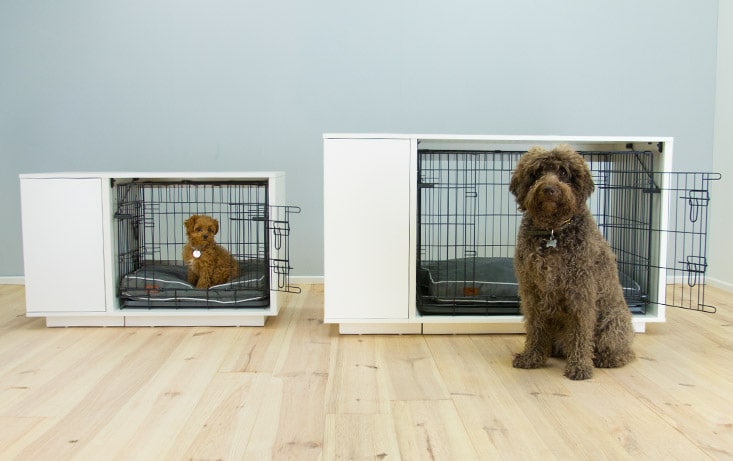
This entry was posted in Dogs
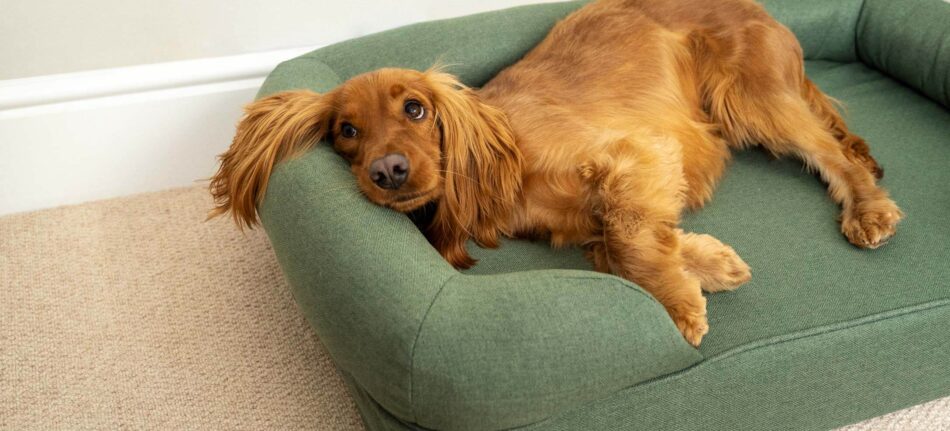
If you have been mattress shopping lately you know how tiring it can be to find a new bed. What about finding the right bed for your four-legged friend? Shopping for someone, or some dog, else can make the options feel even more overwhelming. Should you get a round or square bed? Soft or firm? And does paying a premium for a dog bed really make a difference like it does with our own mattresses?
If our dogs could talk, the one feature they would all agree they want in a bed is comfort! Fortunately, Omlet not only knows dogs (we speak their language fluently!) but we know dog beds, too! So let’s sort the stuffing from the fabric and break down the best in comfy dog beds.
Importance of comfort
Everyone needs a comfortable place to sleep and our dogs are no different! Whether your four-legged friend likes a firm surface or a fluffy pillow to slumber on, comfort and support are essential to their health. A comfy dog bed can not only give your pup the support and warmth they need to aid in providing more quality sleep, but can also support aching joints or other health conditions such as hip dysplasia and arthritis.. And more quality sleep = more quality of life! Once you understand your dog’s specific needs, you can better identify which bed will provide them the best comfort.
We know that dogs love to sleep and, like humans, they enjoy being comfy when they snooze. Our pups are both daytime nappers and night time snoozers so their happiness is directly dependent on the comfort of what they are sleeping on. When their sleep is disturbed, particularly due to lack of comfort, dogs can get grumpy, just like sleep deprived humans! And no one person or pup can function very well after a poor night’s sleep! That is why a comfy dog bed not only gives your pup the support they need to slumber, but also a cozy spot of their own where they can relax!
How to choose the right dog bed
By nature, dogs are denning animals which means they instinctively look for safe, warm spots where they can retreat. Dogs in the wild would not lay to sleep on the hard, cold ground as their first choice. Instead, they would seek out a soft patch of grass or kick together leaves to create a cozy spot to lay. So, naturally, our four-legged friends that are part of our family want the same comfort!
But how do you know which bed is best for your dog? Considering what position your dog likes to sleep in will give you lots of clues. A curled up Chihuahua will prefer a much different bed than a spread out Spaniel. Once you’ve determined your dog’s favorite way to sleep, now you can focus on what they will sleep on the best.
Soft vs. firm?
Soft pillowy beds can offer duvet-like comfort for dogs who enjoy really squishing down into a dreamy slumber, but they can be difficult for more senior dogs (and puppies alike!) to get in and out of. Memory foam mattresses provide excellent support to give your pup the dreamy comfortable sleep they need! Just be sure to find a bed that will supportively mold to your pup’s body as that will provide the greatest comfort.
Elevated vs. ground?
An elevated dog bed with sturdy leg supports may be a good option for your canine as it allows for greater airflow. For dogs who tend to sleep hotter in the summer months, you can add a cooling mat to increase the sleeping comfort level. And conversely, for the pups who get colder in the winter months, an added dog blanket will make the elevated bed that much more comfortable. A raised bed also helps to reduce the dreaded dust hairballs and eliminates carpet stains altogether. Plus, an elevated bed looks like a piece of furniture so now your dog bed just gave your interior an upgrade!
Quilted vs. sheepskin?
The type of material your four-legged friend sleeps on is almost as important as the dog bed itself. Your puddle-jumping Pincher may benefit more from a washable microfiber topper, while your Bulldog may better like a bolster bed topper. Regardless what material your comfy dog bed is made of, make sure it can be removed and is washable! If you are still unsure which material your pup would prefer, try taking this short quiz to identify the perfect match for their personality!
Big dog comfort
When it comes to big dogs, such as Great Danes, St. Bernards, and German Shepherds, they need big beds! While every breed is different, a big dog that sleeps on his side or curled up requires a bigger space to provide adequate comfort. Because big dogs weigh more, it is important to find a bed that is not only firm enough to cushion their joints, but also a bed that is durable to handle their more powerful digging! Omlet recommends memory foam mattress beds as the best option for your big dog.
Small dog comfort
If you have a pint-sized pup at home you know all too well that they usually like a good cuddle session! Most smaller dogs like Pomeranians, Papillons, and Terriers, prefer a smaller space to snooze where they can comfortably nest and feel secure. Donut beds or smaller bolster beds are both great options for the small four-legged family members! In addition, non-elevated beds are easier for really tiny breeds to climb in and out of.
Puppy vs. senior comfort
While puppies and senior dogs are different in age, their idea of comfortable sleep is very much the same! Senior dogs need lots of support to comfort their aging joints and possible arthritis, so firmer memory foam mattresses are the best option to keep them happy sleepers. Puppies also need a firm, supportive mattress to provide comfort for their quickly growing bodies. Just be sure your puppy dog bed has a removable and washable cover for the inevitable “puppy accidents.” Both senior dogs and puppies can experience more anxiety, so a bolster bed that provides the extra sense of security they need is a perfect option for younger and older furry friends alike!
Luxury beds
When it comes to comfort, our dogs are not that different from us humans – they appreciate a luxurious place to sleep as much as we do! But should you ‘break the bank’ on a new dog bed for your furry friend to ensure they have the most comfort? Not necessarily. Omlet recommends three main factors to consider when finding the perfect comfy dog bed for your canine companion: Good for the dog. Good for your wallet. Good for the environment.
Take time to understand your dog’s specific needs and sleeping style and then look for beds that offer both the comfort they require as well as the capabilities to be a bed they will use for a long while. At Omlet, our mission is simple – offer a dog bed that is crafted with ultimate comfort to be a constant companion for your constant companion! Sure, you could buy a new, run-of-the-mill dog bed every few months that will end up in a landfill when you are done. Or, you can invest in a customizable sleeping solution that can grow with your dog and his changing needs!
When the Omlet product designers created the Topology Luxury Dog Beds, they asked themselves one simple question: what if a dog bed could live forever? And, as a result, the “only dog bed you will ever need” was born!
How to make your dog’s sleeping environment comfortable
Now that you have a perfect comfy dog bed for your pup, how do you make the sleeping environment around the bed comfortable as well? Here are some tips to help create a relaxing and comfy environment:
- Get some steps in! Make sure your dog gets plenty of exercise as this will help to tire out any extra energy that may prevent a relaxing siesta!
- Eat good food! Nutrition is an important part of your dog’s overall sleepy happiness so be sure to feed them high-quality nutrition that is easily digestible.
- Your energy is their energy! Remember that dogs (and most animals!) are highly sensitive creatures. They can sense your energy – both positive and negative – so the more you can remain calm, the more they will too.
- Create a safe place! There is nothing wrong with having multiple dog beds throughout your house if your dog likes to sleep in all the rooms! Just try and avoid placing beds in open spaces and look more to locate them against a wall in a quiet spot so they can feel the most comfort.
We can all agree that there truly is nothing better than a restful and comfortable bed to snuggle and snooze in! No matter the breed, age, or size of dog, they would all agree that a comfortable bed is paws-itively the best option for them, too!
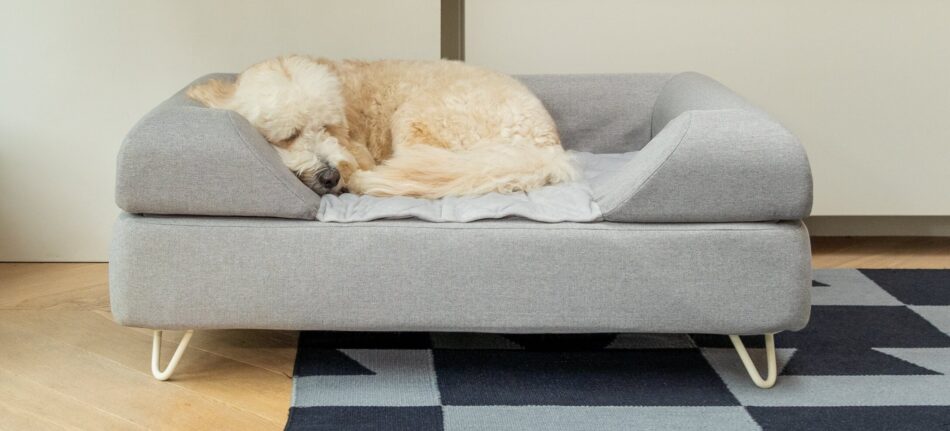
This entry was posted in Dogs
Cooling down your dog in the hotter months is good for their health, and their happiness! Some dogs, like humans, are sun worshippers and love basking in the saturated golden rays of warmth. Whereas other dogs prefer a nice cool spot to lay in the shade with a big bowl of cold water to sip. But are some dogs more susceptible to the dangers of heat than others? And once they are too hot, how do you cool down a dog?
When it comes to hot temperatures, the age, dog breed and health of certain canines can be a big factor in whether they can handle the heat as well as others. So wherever your dog falls on the summer sun scale, Omlet has the products you need to help your canine companion stay cool during hot weather months.
How to tell if your dog is too hot
Unlike humans who sweat when we are overheated, dogs do not perspire. Instead, their breathing starts to increase in an attempt to regulate body temperature and cool themselves down. If you are out with your furry friend enjoying a hot summer day and they start rapidly panting, that is your first sign they are getting too hot. Understanding these signs of overheating and steps to cool down your dog are vital to your dog’s health.
Have you ever pet your pup outside in summer and felt their skin was super warm to the touch? This is because dogs innately divert their blood away from their organs when too hot to try and allow the heat to leave the body faster. So a good rule of thumb to remember is when your dog feels hot to the touch, it’s time to get them somewhere cooler right away!
In the event these natural canine cooling mechanisms are overlooked, other signs that your dog is too hot will be more blatant. These will include:
- Extreme lethargy
- Vomiting
- Bright red gums
- In severe cases, seizures
Overheating is a serious concern in dogs and, if overlooked, can be quite dangerous. When any of these symptoms are cause for concern or become severe, take your dog to the vet to be seen right away.

Causes of canine overheating
Heat stroke, or elevated body temperature, in dogs is generally associated with a body temperature of 103 °F (39.4°C) or greater. There are many different ways this can happen and it’s important to be aware of them all:
- Hot cars: The most common cause of canine heat stroke is being left in a parked car without any ventilation. Even on days that may seem tolerably warm to humans, the temperatures in a locked car can rise to well over 100°F rapidly. And we all know that even a parked car in the shade with the windows down on a hot day is still not good for our dogs! So while it’s fun to have our furry friends go everywhere with us, it’s best to avoid any summer heat trips that will require your pup to stay in the car.
- Exercise in heat: Did you know that too much exercise in the heat of the day can be detrimental to your canine? Even with adequate water and shade, excessive exertion at high temperatures can raise a dog’s body temperature too quickly to be cooled down. So try to only walk in the morning or evening when temperatures are cooler and place plenty of water bowls around the house during the day!
- Specific dog breeds: Certain flat-nosed breeds, like pugs or bulldogs, have an even harder time handling the heat due to their restricted airways. These dog breeds need even closer monitoring when outside in the heat. In addition, dogs that have underlying medical issues, such as lung or heart conditions, are also more susceptible to hotter temperatures.
Understanding what causes heatstroke in dogs is vital to their health. But the best way to cool down your dog in the hotter months? Make sure they don’t get overheated in the first place!
5 Ways To Cool Down Your Dog
So what if your dog is too hot and you need to cool them down quickly? Here are a few tips on how best to keep dogs cool in the summer months or during any unexpected heatwave:
- Adjust exercise times! The early morning hours are the best time to get out on a walk or play a good game of fetch during the hot summer months. But before you leash up your pup, be sure to feel the pavement with your hand or bare feet to see if it feels too hot. If the ground is too hot for you, then it’s too hot for your furry friend, so head back inside to stay active with some dog toys instead!
- Get a cooling mat! One of the quickest ways to cool down your dog quickly is to lower the temperature on their skin. Laying directly on a cooled mat will provide the perfect comfort solution! The Omlet Dog Cooling Mat is a great option because it doesn’t require any electricity or refrigeration to effectively cool down your dog. Designed as a foldable memory foam mat, you can take this mat wherever you and your furry friend go so they will always have an escape from the heat!
- Brush, brush, brush! Certain breeds, especially those with thick fur and long hair, are more susceptible to heat because of that extra coat they are carrying. One way to cool them down is to groom and brush them more frequently during the summer months. A dog’s health and hygiene are always important to stay on top of for your pup, and brushing out some of that extra fur is a big help! Just don’t grab the clippers and give your dog a buzz cut – many dogs, like Labradors, have a second coat that actually acts as a natural ‘first-defense’ cooling system so trimming that away would actually be worse!
- Fresh cool water is a must! Think of how good a big glass of iced water feels to you on a hot summer day – your dog appreciates it just as much! During hot summer months, it’s important to keep your canine hydrated with lots of fresh cold water. You can even place bowls throughout your house to encourage frequent drinking. And don’t forget a portable water bowl or ice cubes to chew on when outside – your dog will love a frozen treat to cool off with!
- Summer swimming for everyone! A cool dip in a lake or the ocean is a favorite summer activity for most humans, and for dogs who are used to swimming, they love a summer swim just as much! Splashing in the waves and water is a great way to cool your dog down – just make sure they don’t overdo it on the exertion! If you don’t live near a body of water, you can always grab a kiddie pool or sprinklers to keep your pup cooled off. Who doesn’t love cool water on a hot summer day?!
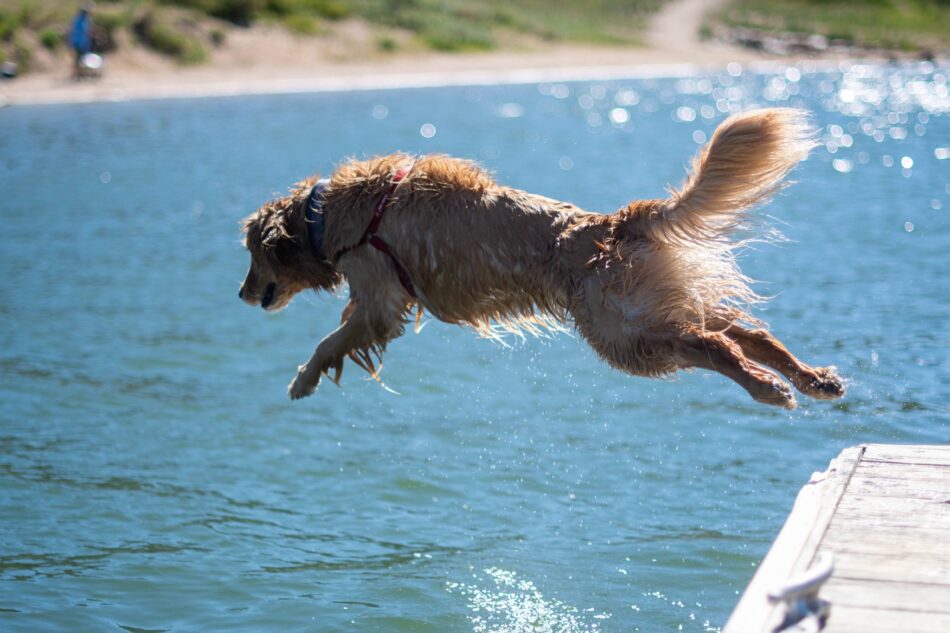
Tips To Stop Your Dog Getting Too Hot
When it comes to high temperatures and hot summer months, we know that the best way to keep your dog cool is to avoid anything that will create more heat.
- Avoid putting your dog in cars altogether during the hotter months.
- Try not to exercise in the heat of the day. Instead, enjoy shorter walks and the air conditioning inside together!
- Stay away from any activities that are not near fresh water to dip in or sip on.
- If it’s too for you, it’s too hot for your dog!
Summer routines often change for humans, and that is a good time to adjust schedules for your furry friend, too!
Dog Cooling Mats
An excellent option to help your canine stay cool in the hot summer months is a cooling mat they can lie on while sleeping. The Omlet Memory Foam Cooling Mat is a great choice because it provides hours of comfort without the need for refrigeration. Here are some benefits of the Omlet Cooling Mat:
- Designed with self-cooling gel: This mat is made of a highly conductive material that absorbs the heat from your pet and provides up to 3 hours of cooling effects. The closed cell structure design also keeps the cooling gel exactly where you want it – directly under your dog!
- Completely portable: Because this mat does not require any electricity or refrigeration, you can take it with you anywhere your dog goes! So for those summer beach vacations with your dog, don’t forget the cooling mat to keep him comfortable!
- Ultimate comfort: Designed with dogs in mind, this cooling mat uses premium memory foam to ensure the most comfortable cooling solution. This mat will not only keep your dog cool in the summer months, but also help to cushion any achy joints!
- Easy to clean: Constructed of non-toxic materials, the Omlet Cooling Mat is safe to use for dogs of all ages, including puppies! And speaking of puppies, this mat is also waterproof and rip-resistant so it can grow with your dog!
- Multiple sizes: The Omlet Cooling Mat is not a “one size fits all” cooling solution – it comes in 3 different sizes to fit every dog! And whether you have a large bolster bed or a small sheepskin bed, this mat can easily fit inside to provide hours of cooled comfort!
Recognizing the signs and symptoms of overheating in a dog allows you to react more quickly. And when you know how to cool your dog down and be safe in the hotter months, you can both enjoy the summer better!
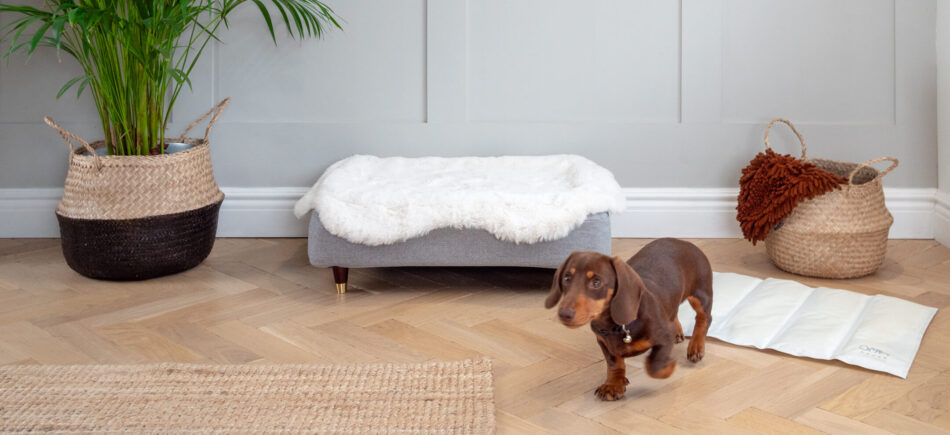
This entry was posted in Dogs
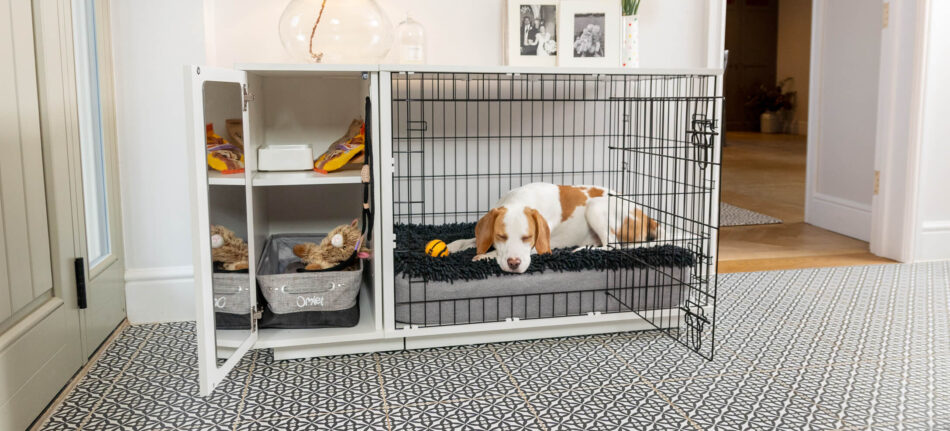
Any dog-loving pet parent will agree that when it comes to our pets, dogs are part of the family, too! And just as we prioritize good hygiene for ourselves, it’s important to keep up good hygiene for our four-legged family members as well.
But what is involved in “good dog hygiene”? Are you supposed to brush your dog’s teeth every day? Or give them a weekly bath? Should dogs have their own skincare routine? We are here to sort out the essential dog care products so you can rest assured you are supporting your dog’s health and hygiene as much as your own!
Pup-ular essentials
Whether you are a new dog owner or a seasoned pet parent, you know that bathing and hygiene are important components of caring for your dog. But did you know that properly caring for your dog’s hygiene requires more than just a bath every few weeks? Support of your dog’s overall health should be inclusive of several key factors:
Hygiene
The best hygiene regimen for your dog is really dependent upon your dog’s specific lifestyle, breed, and any underlying medical conditions. Dogs who like to roll in the dirt daily may need baths more frequently than those that are couch pup-tatoes. And if your dog has sensitive skin or allergies it is always best to consult with your vet on bath time needs and routines.
But bathing your dog isn’t the only aspect of hygiene! Sure, they need a good shampoo that is effective in getting rid of dirt and fleas, but don’t forget their teeth! Doggy dental care is just as essential to your dog’s health as it not only prevents possible gum and tooth pain, but also helps to avoid any bacteria build-up in the mouth that could potentially grow and spread. So be sure fido flosses weekly!
Leashes / Harnesses
Having a durable and study leash or harness is an essential “must have” dog care product for every dog-loving pet parent. One of the best parts of owning a dog is getting to go out and enjoy walks with them and explore! Exercise is an important part of your dog’s overall health as it will keep them young and healthy longer!
Whether you are buying a leash or harness for your dog, it’s important that you find one that fits their size and is comfortable for them to wear. Leashes also provide security for your dog so they don’t roam into harmful areas when out on a walk! Remember, happy tails are found on outside trails and most require dogs to be on a leash!
Nutrition
It should go without saying that proper nutrition is an essential dog care product no matter the breed or age of dog! Just like humans, dogs feel their best when they are eating proper nutrition. We know that an unhealthy meal can make us feel sluggish and tired. Same goes for our dogs! To maintain a healthy life, most dogs require a balanced diet that includes a mix of protein, carbohydrates, fats, vitamins and minerals. And be sure to always consult your vet on your dog’s specific needs and diet requirements.
Dog bedding
We know that dogs like to sleep a lot! That is precisely why a good dog bed is an essential dog care product to buy. Having a bed to call their own that is comfortable can make all the difference in the life of your dog! When it comes to good hygiene, the most important part of the dog bed is keeping the cover clean. Washing the bed topper and doggy blankets weekly is a good way to keep bed bugs at bay! So be sure your dog bed cover is removable and washable. And remember, a well-slept pup is a well-kept pup!
Importance of Hygiene
We know that bathing and dental care is important for our dog’s health, but what exactly is expected in a good hygiene routine?
GROOMING/BRUSHING:
Even if you only bathe your dog once a month, it is important that you brush their coat at least a few times a week. This practice not only feels good for most dogs, but helps to eliminate excess fur and allows their skin to breathe better. Long-haired dogs, such as Golden Retrievers and Newfoundlands, may require daily brushing, whereas short-haired Boxers and Beagles don’t need as much! So depending on your dog’s breed and coat, either a brush or a comb will work well in your dog care essentials.
CLEAN WATER BOWLS:
Do you drink out of the same glass of water every day without cleaning or refilling it? We didn’t think so! Well, guess what? Your dog shouldn’t be either! It is important to the overall health of your dog to wash their food and water bowls daily to clean out any dirt and bacteria build-up. Stainless steel and melamine bowls are among the best choices for water bowls as they are easier to clean and don’t capture the bacteria as much as plastic bowls. The Omlet Bowl is a great option as it is both dishwasher safe and stylish!
BEDDING/TOY CARE:
On average, most humans wash their bed sheets at least once a week. But what about your dog’s bed cover? The same reasons you wash your own sheets are why you should also wash fido’s! The Omlet Topology Luxury Dog Bed is a great option thanks to the removable, washable toppers! Literally just unzip the top cover and throw it in the washing machine to do the dirty work, and in the meantime zip on a fresh topper so your pup is never without their dog bed. We also suggest frequently washing your dog’s favorite toys in warm soapy water to eliminate any potentially harmful bacteria.
Higher maintenance hygiene
All dogs need good hygiene, but some may require more care than others! Certain breeds like Labrador Retrievers, Dalmatians, and Boxers tend to be more allergy prone. These dogs can often have skin irritations or other allergy related issues that may require more frequent bathing and care. In that case, oatmeal or medicated shampoos may be needed for the best cleaning. Your vet can help you create the best bathing and grooming schedule for your dog based on his specific needs.
Other breeds that may require a higher maintenance hygiene regimen are those with specific physical traits like flat-noses or curly tails. Bulldogs and Pugs are examples of dogs that require greater hygiene around their faces to ensure proper care and cleaning. Bacteria likes to hide in the folds and creases of the flat-nosed faces so a good cleaning to these areas is imperative! Likewise, Akita’s and Chow’s will need more attention paid to their tails when grooming. Just like the flat-nose breeds, curly-tail breeds can attract bacteria to the folds of the tail so wash that area well to avoid any dermatitis or irritation.
New puppy checklist
When it comes to puppies, their dog care product list is very similar to adult dogs. You want to be sure you provide them good nutrition, a well-fit leash or harness, a comfortable bed, and of course, good hygienic care. Some additional essential products to add to the puppy care list would be a secure dog crate for training and mini dog treats for rewarding new learned behaviors. And having a few hard rubber dog toys on hand is a must for those sharp puppy teeth!
When it comes to bathing a puppy, avoid giving them a bath more than once a month. At this early stage of life, puppies are still developing their natural oils on the skin and fur so too much bathing can strip away those oils quickly. Also, be sure to use lukewarm water in your puppy tubby time – the warmer sensation reminds them of their mother’s natural licking which will, in turn, provide a better sense of calm at bath time!
Whether you are an experienced pet parent or a brand new dog owner, having the essentials in dog care products is important for your dog’s health. Pet parents need to consider their dog’s individual needs and buy products specific to their breed, age and lifestyle. These essential dog care products will better provide a healthy, happy life for your four-legged friend, but the most important of all is the love they get from you!
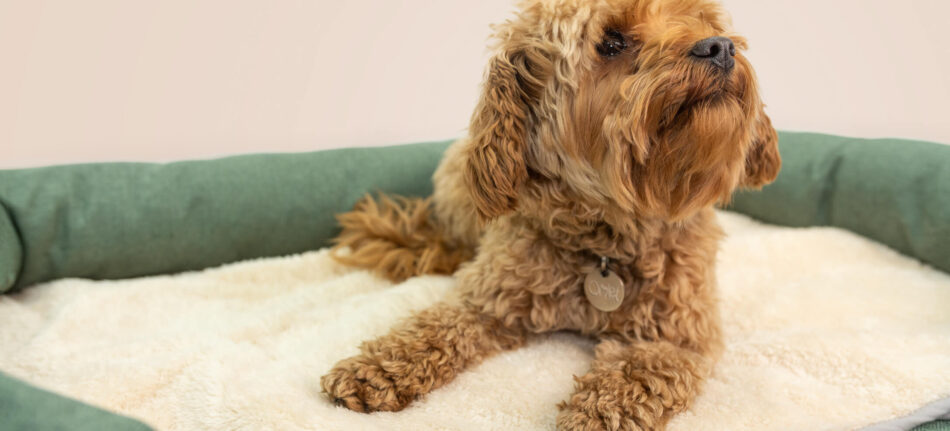
This entry was posted in Dogs
Sleep, eat, nap, play, nap, eat, sleep, repeat….the wonder of a dog’s life! For many pet owners, the sleeping schedule of a dog is an enviable life!
But how many hours of sleep a day do dogs really need? Do Dachshunds need more or less sleep than Danes? Is it ‘normal’ if your dog is sleeping more than half the day away? Omlet knows dogs and we are here to support you and your sleepy pup so everyone can get a good night’s rest!
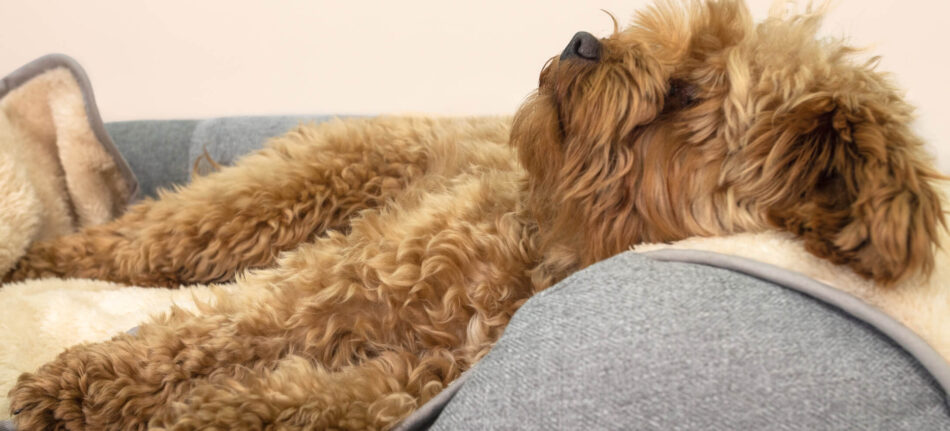
Why do dogs need so much sleep?
Dogs are natural born social sleepers. Unlike humans who abide by circadian rhythms (or a natural sleep-wake cycle in a 24-hour period), dogs can doze anytime of the day and often in any place! But why so many siestas? Sleep provides the same benefits to dogs as it does their owners – it’s a time for the mind to process all it learned that day. Periodic snooze fests throughout the day allow dogs to rest their brains and process all of the information they have absorbed. Just like humans, a dog’s brain needs time to filter through life events and sleep offers the perfect outlet for that! In addition, dogs have heightened senses of hearing and smelling so their brains are taking in more information at a faster rate. Napping and sleeping gives a dog the recharge they need to keep those sniffers active!
Do certain breeds need more slumber? All tails wag “yes” to that question! Age, breed, and even activity levels all play a role in a dog’s snooze schedule. Sleep is essential for all dogs but there are definitely some that like a good cat, er canine, nap more than others! And if you are a new dog owner with a puppy at home, you need to keep reading…
How much sleep a day do dogs really need?
On average, most dogs sleep 12-14 hours a day. Yes, that is correct – half a day spent in a snoozy dreamland! However, unlike humans who get all their beauty sleep in a 7-9 hour restful night stretch, dogs tend to sleep in more irregular patterns. Our furry friends are sleep savourers and rarely get all of their sleep in one long stretch.
While puppies and senior pups sleep closer to 18-20 hours a day, most dogs clock in the shuteye in 45 minute increments throughout the day. Precisely why a good dog bed is imperative for your four-legged napper to truly relax!
Adult dog slumber
Each breed is different, however, most dogs are considered ‘adult’ between the ages of 1 to 5. Since dogs age faster than humans, this stage of their life is when they are the most active, so sleep is still important…just not as much as when they’re a growing puppy. Adult dogs typically only need 8-12 hours of snoozy time to fully recharge.
You may notice your adult dog playing a hard game of fetch or energetically running around in the backyard only to come to a full stop moments later and go straight to sleep. Consider this their automatic reset and totally normal! Dogs are great listeners to their bodies and very good at reacting to what they physically need. So when their body says it’s time to rest, off to a quick nap they go! In addition, dogs process the environments around them through sniffing, hearing, and seeing. After taking in a lot of smells and sounds all at once, a quick snooze is often in order to help their brain make sense of it all. But don’t worry, they will be up and at it again in no time!
Sleep for puppies and seniors
What do puppies and older senior pups have in common? The need for more sleep! If you have ever had a puppy, you know all too well why raising them is often compared to raising human babies. Puppies are pro-nappers! They grow quickly – reaching full maturity as early as 6 months old for some breeds – so they also burn energy quickly. With all that playtime in the early months, puppies need to recharge with frequent sleeps to maintain that level of fun.
Senior dogs like lots of naps too, but not because of the same reasons as puppies. Around age 6 for most dog breeds, their metabolism starts to slow down so sleep is imperative to restore their energy. Just like humans, as dogs get older, their sleep gets longer. Your senior pup will tire faster from any exertion and sleep is their conduit to recharge, replenish, and refresh. So don’t worry if your pouncing puppy or senior pup is snoozing 18-20 hours a day off and on – it’s completely normal!
Day vs. night sleep
If you had the option to stay up late or sleep in late, which would you choose? Your dog may choose either – OR both – depending on the day! We know that dogs can sleep for 50% or more of their day, but when they get that sleep is dependent upon their age, breed, and the sleeping habits of you, their owner. While humans wait until night time to rest the brain to organize the thoughts and events of the day, dogs can get the same organization of thoughts with frequent sleeps throughout the day.
Dogs will often mimic the sleep patterns of their owners. If you maintain a 9-5 work schedule, you can expect that your dog will catch most of their zzzs while you are at the office. Exercise and activity are important for both a dog’s physical and mental health, so be sure to get your canine companion out for a walk or a good game of fetch before turning in for the night. Tired dogs will stay at rest longer for a night time slumber!
Does breed matter?
So your pug is sleeping more than your border collie? We know that age plays a role in a dog’s sleep patterns, but breed of dog can also be a factor. If you are looking for a lazy fur friend to spend your days with, you may want to consider a Mastiff, Bulldog, St. Bernard, or Beagle as your companion. Conversely, if you are seeking a minimal nap active pup for lots of outdoor activities, then Pomeranians, Labrador Retrievers, or Airedale Terriers will be more your style.
Why do certain dogs need more sleep than others? Exactly how much sleep a dog needs depends on what their specific breed was bred for. For example, dogs that were bred to watch over the livestock or be alert to dangers are less likely to doze off as frequently during the day as their canine counterparts. In addition, large dog breeds may tend to nap more often because they tire faster with all that extra puppy love to carry around!
Let sleeping dogs lie
Don’t bother fixing something that isn’t broken, right? When it comes to dogs and sleep, that is mostly true. Keeping an eye on your dog’s sleep patterns is always important as it will tell you a lot about their physical and mental health. Here are a few key indicators to keep in mind!
Activity
A dog in motion stays in motion! Especially for dogs that are home alone most of the day without any stimulation, it is important for their health and sleep to still get exercise each day. Walks, chew toys and interactive games are all good options to keep fido active and sleepy!
Nutrition
Indigestible diets can lead to lethargy, so be mindful of what fido is feasting on. Just like we don’t always feel great after a huge buffet of greasy food, our canine companions can also feel the impacts of a not-so-indulge-worthy meal.
Mental Health
Anxiety isn’t just for humans – a worried dog can have irregular sleep too! Yes, our furry family members can feel stress, so if you start to notice a change in their normal sleep patterns (i.e. up all night when they used to snooze through until morning), schedule a visit to the vet to get your dog checked out.
Environment
Can you sleep well when it’s too hot or too cold? Neither can your pup! Remember, dogs don’t sweat – they pant. So if you notice they are panting heavily after exertion, they likely need to cool down before a snooze. And if they are curled up in a tight ball before bed, that might mean they need a blanket to get some zzz’s!
Better sleeping habits
Thankfully, identifying the reasons your furry friend may not be sleeping their best is a pretty easy task. Once you pinpoint the issues, you can easily encourage better sleep habits with these tips:
Give a dog a bone! Chewing promotes relaxation for your four-legged friend and is a great stimulation activity for fido while you are at work all day. So stock up on chew toys to encourage more restful slumber!
Healthy diets promote healthy sleepers
Well-balanced diets aren’t just for humans – your dog needs good nutrition, too! Nourishment of high quality proteins, fats, carbohydrates, and fiber will ensure good health and good sleep. And don’t forget regular health and hygiene will also ensure better sleeping habits for dogs of all ages and breeds!
Comfort is key!
Finding ways to comfort an anxious pup can be as easy as finding the right bed! We spend hours debating over the right mattress for ourselves, we often forget that the right dog bed can make all the difference in our pup’s sleep!
Climate is everything!
In the hot summer months, or if your big dog is just a hot snoozer, consider a cooling mat to keep those naps nice and cool! And when the winter temps blow in, remember that dogs tend to sleep more because there is less sunlight for them to produce melatonin! So be sure to have their favorite dog blanket on hand to get cosy again.
So whether you have a puppy or a senior, a greyhound or a German Shepherd, all dogs need sleep! Life is ruff for our furry friends and sleep is how they grow and stay healthy. But as man’s best friend knows best, when the going gets tough, take a nap!
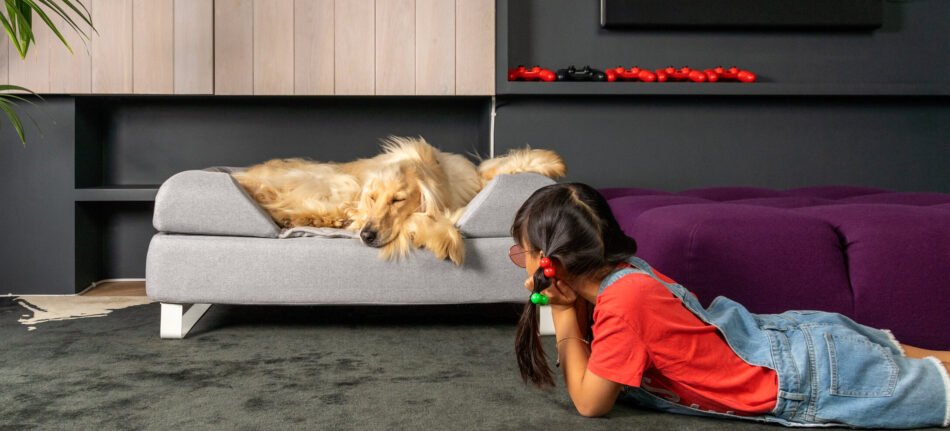
This entry was posted in Dogs

If you have ever raised a child from baby to adult, you know all too well the joys, headaches, tribulations, and rewards that come with that experience. But what about raising a four-legged baby? You know, the kind that has fur, a wagging tail, and slobbery kisses for days. Is raising a dog the same as raising a human? Our fur babies may not be able to communicate what they want as well as human babies, but that doesn’t make them any less a member of the family. To build and maintain an everlasting bond with our dogs, it is essential that we understand their needs in every stage of life.
As discovered in our previous blog, How Old Is Your Dog In Human Years, our canine companions age much faster than their human brothers and sisters. A poignant reminder that every moment counts and each cuddle could last a little longer. So how long is a dog considered a baby? When do you know if your pup has officially entered the scary, yet delightful, teenage years? And how can we better support our senior pups in their prime as they slow down? Here is a helpful list to guide you and your dog through these precious stages together.
Puppyhood
The cuteness overload puppy years! This is the time when your fur baby still has that intoxicating puppy smell and abounding energy. Depending on the dog breed, this stage of a dog’s life is usually between birth and 18-24 months. Just like humans, this early phase of development is where your dog will learn basic socialization skills. You want your fur baby to be a part of the family, right?
There are several different ways to engage your energetic and curious puppy. Spend lots of time during this stage talking to them, petting them, and teaching them all the rules like potty outside, sleep through the night, and don’t chew on the furniture. Omlet offers a variety of dog toys that would be perfect to help train those sharp puppy teeth to stay off the couch! Your pup will also grow the most during this stage of life, so good quality nutrition and veterinary care are also essential in making sure fido flourishes. Puppies can be a lot of work, but with consistent routines and training, you will have a teenager (eek!) before you know it!
Adolescent to Adult
What’s that? No exhausting toddler years to navigate with dogs? That’s right! Most pups will reach “adulthood” by the age of 3, which means the adolescent teenage years are short depending on the dog breed. Smaller breed dogs, such as Chihuahuas and Dachshunds, become teenagers around 6 months old, while larger breed dogs, such German Shepherds and Great Danes, become adolescents around 3 years of age. While most of the obedience training occurs during the puppy years, you want to continue positively reinforcing good behavior at this stage. Adolescent dogs are a lot like adolescent humans – they will start to test the boundaries around this age. Just when you thought you mastered the “sit, stay, shake” commands, your adolescent to adult dog will start to challenge you by ignoring these learned behaviors, so don’t fall asleep at the wheel, or leash.
Mental stimulation is also important across all developmental stages, so keep your teenager pup engaged with lots of activities like fetch, doggie play dates, and games. The key to this stage? A tired dog is a well-behaved dog! And don’t forget your dog’s health and hygiene which is important regardless of age. Most healthy adult dogs still need consistent exercise and, depending on dog breed and temperament, that could be up to 25 mins a day. So make it a family affair – grab both your teenage human and teenage dog and get everyone out on a walk!
Prime Senior
Just because your fur baby is now a fur senior doesn’t mean you have to start looking into retirement homes for your canine companion. Older dogs are still active dogs! Our previous blog, Caring for an Older Dog, provides great insight on how to best navigate these prime years. If you have had your fur baby since puppyhood, you may start to notice your now white-muzzled pup slowing down the pace a bit around age 6. Perhaps you notice yourself slowing down a bit as well to mirror their behavior and better care for their changing needs. That’s a good thing! Instead of one long walk each day, consider taking your senior on a few short walks to maintain exercise without exhaustion. You may find you like this new change of pace as well!
Many prime senior pups will also start to change behaviors at this stage with some mobility and cognitive changes, so it is important to keep up with regular vet care visits to monitor any significant issues. Can’t teach old dogs new tricks? Nonsense! Older dogs can absolutely learn new tricks, but just like senior humans, keep the food rewards to a minimum as metabolism starts to slow down in this stage. In addition, some older dogs may begin to have joint problems around this stage, so ensuring you have a comfortable and supportive dog bed is critical. The Omlet Topology Luxury Dog Bed is a great option to customize a sleeping solution fit for a king, or queen, senior. Regardless of dog breed, older dogs of all shapes and sizes are still as enjoyable and lovable as puppies!
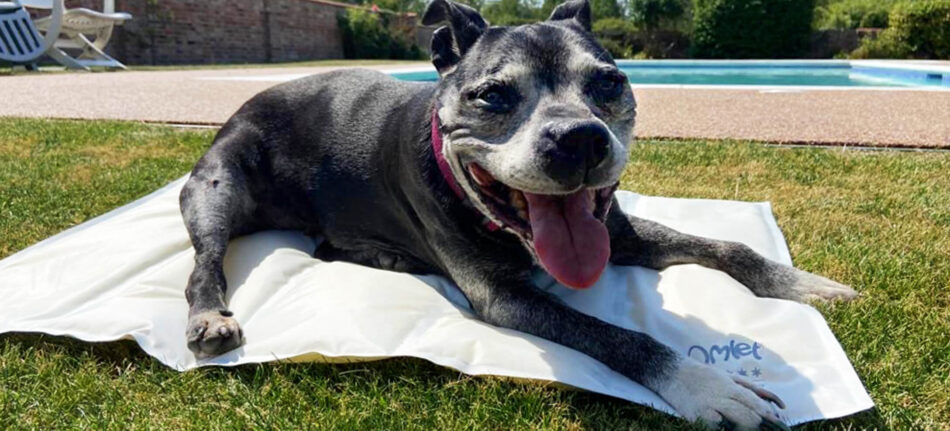
Pet owners know that taking care of a dog, at any stage of life, is a commitment full of work and reward. Whether you have a bouncing puppy that is still learning how to walk on a leash or a prime senior who loves to just lay in the sun, there is much to be gained from every stage of a canine’s life. And even though our fur babies are not around as long as our human babies, it goes without saying that the love they give is invaluable no matter what age. So enjoy every moment of every stage!
This entry was posted in Dogs
The temperatures are rising, the days are longer, and the itch to travel is strong. That can mean only one thing – summer is officially here!
Beach vacations are one of the top destinations this time of year for both two-legged and four-legged visitors who are longing for the salty air breeze and cool, crisp splashes in the ocean surf. While many beaches across the US coastlines allow your furry companion to visit, some places are more welcoming than others.
Whether you are wanting to go south into Florida, up to the northeast for cooler summer nights, or out west to dip your toes into the Pacific Ocean, there are many amazing beach destinations for all the members of your family. Here is a list of some of the top dog-friendly beaches to visit this summer.
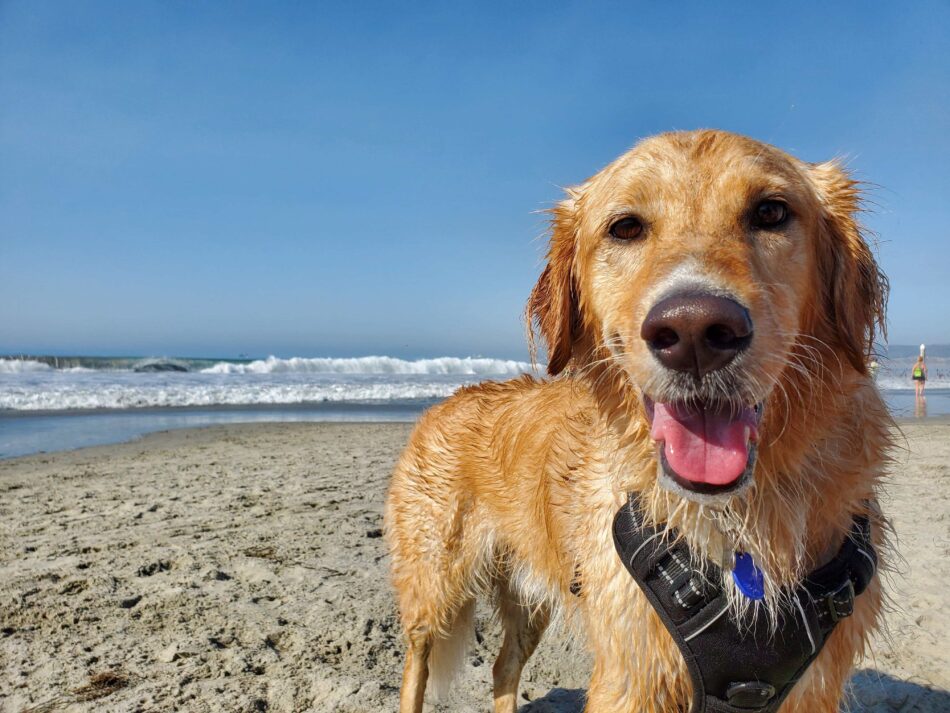
Oak Island, NC
Imagine running along the salty beaches of the Atlantic Ocean while the sun is starting to rise over the water. Your dog is splashing in the surf and barking out sounds of pure joy as his paws sink into the same soft sand as you. That is what it feels like to vacation in Oak Island! Part of the Brunswick Islands, Oak Island is a small, quaint town in southeast North Carolina. This dog-friendly city hosts hundreds of furry guests each year with its plethora of pet-friendly vacation rentals. You and your dog will have a fetching time enjoying sweeping views of many appointed beaches in the area – just be sure to read up on the leash regulations prior to your visit as required on-leash hours vary depending on location. Looking for other furtastic things to do with fido while at the beach? Head over to the Salty Dog dog park where your four-legged friend can mingle with other local and vacationing canines alike. This beach is a doggie must!
Huntington Dog Beach, CA
Is it paw-ssible to find a beach that is all about the paws? Absolutely! Welcome to Huntington Dog Beach in California. Located south of Los Angeles along the coastline of the Pacific Coast Highway, Huntington Dog Beach is a pup paradise vacation spot. This “ultimutt” beach destination is managed by a non-profit group of local dog-loving residents and boasts year-round, leash-free stretches of beach that are open to dogs of all shapes and sizes. Huntington Dog Beach is also the hot doggie spot for many dog-centric events each year. Does your pup like to surf? Grab some pupcorn and be sure to catch the Salty Pup surfing competition that Huntington hosts annually. Since the Pacific waters stay cooler year-round, your dog can cool off while running in the waves – be sure to pack the Kong Squeak Air Ball to maximize the fun for fido. Huntington Beach has consistently been voted as one of California’s dog-friendliest cities so it’s a guaranteed good time vacation for all!
Dog Beach, Ft. Myers, FL
Another pawsome vacation spot that caters to dogs and their owners is the famous Dog Beach in Ft. Myers, Florida. You will become your dog’s most pup-ular human by bringing them to play in these calm waters of the Back Bay on this off-leash stretch of white sand. Known for its laid-back atmosphere and doggone good weather, Dog Beach was specifically designated as a county park just for dogs and is a howl-worthy time for furry friends of all sizes. Because the summer temperatures tend to get hotter in southern Florida, be sure to pack Omlet’s Memory Foam Cooling Mat for Dogs to help your pup cool down faster. This easy to travel with mat doesn’t require any refrigeration or plugs – it uses the heat from fido’s body to activate the cooling effects! After a day of fun in the sun, picture walking on the streets of this surfside beach town which are paved with dog-friendly watering holes. Nothing like a cold beverage to end a good day while your canine relaxes and refreshes with a big bowl of water.
Block Island, RI
Does your dog like to swim? If so, then Block Island, Rhode Island is the perfect beach vacation spot to visit this summer. Located 12 miles off the coast of mainland Rhode Island, Block Island is only accessible by ferry boat. But don’t fret, canines ride for free on this paw-ty boat that offers beautiful views of the northeastern part of the country. Here, you and your four-legged friend can enjoy twenty-five miles of swimming, hiking, or just simply relaxing in the cooler waters and surf. After exploring this remote destination, it will be a wonder whose tail will be wagging more with joy. Remember, your vacation is a time to get away from the dog-eat-dog world for a bit, so be sure to stop in for a bite at The Oar restaurant to enjoy some delicious, local seafood. And always have Omlet’s Fruitables Skinny Mini Dog Treats on hand so your pup can enjoy the dining experience as well!
Galveston, TX
Paws-itively one of the best beach destinations to vacation this summer is along the shorelines of south Texas in Galveston. With 32 miles of dog-friendly beaches and dozens of vacation rentals that welcome man’s best-friend, Galveston is not just for humans. At the top of the list for this beach locale is a visit to Kempner Park which offers plenty of shade to wade in the warm waters of the Gulf. You know your pup can doggie paddle, but what about paddleboard? Be sure to check out SUP Gulf Coast to start teaching your old (or young!) dog new tricks. That’s right – this dog-loving company provides life jackets and lessons for both two-legged and four-legged visitors. At the end of the day, enjoy a delicious meal at one of the many local restaurants that welcomes all pooches to relax on the porch.
No matter where your summer vacations take you this year, be confident in knowing there is a long list of beaches that not only welcome your four-legged family members but cater to them as well! One of the best ways to explore new places and experience new adventures is to plan a trip with your dog. After all, it’s called the Dog Days of Summer for a reason!
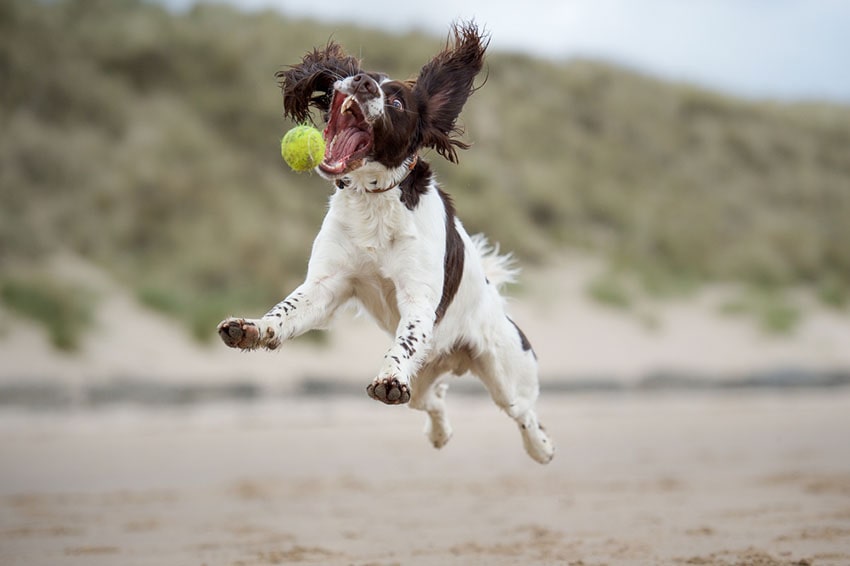
This entry was posted in Dogs
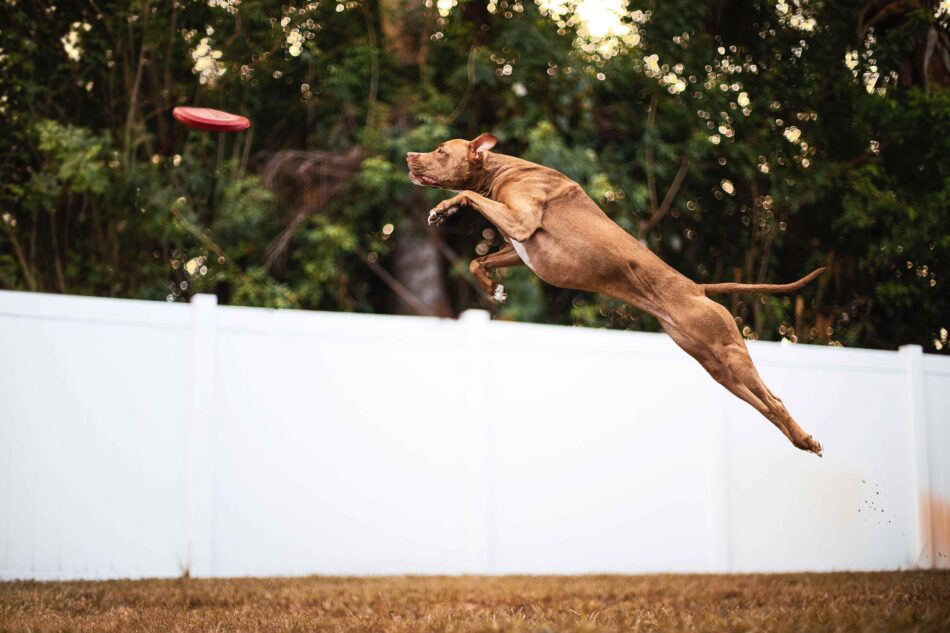
Have you got the world’s cutest dog? Well, probably according to you! But does your furry friend hold any world records? We’re talking extraordinary pooches whose remarkable features and talents have landed them a place in the Guinness World Records! It’s time to find out some fascinating facts about these amazing dogs and the dog world records they hold.
Tallest dog in the world
First up, we have the tallest dog in the world. This world record is currently held by Zeus – a Great Dane from Bedford, Texas. At 3 feet 10 inches tall, this hound needs plenty of food to fuel his supersized frame, specifically 12 cups of it a day!
If you’re interested in finding out more about the world’s largest dog breeds, including Great Danes, take a read of the Omlet Dog Breed Guide. And if you decide that one of these is the perfect fit for your family, then you too could be in with the chance of holding this dog world record one day! Alternatively, take a read of our 5 Ways To Figure Out What Dog Breed Is for You blog!
Shortest dog in the world
The shortest dog on the other hand, is Miracle Milly from Dorado, Puerto Rico. This pocket-sized pooch stands at 9.65 cm (3.8 in) tall, weighing in at only around 1lb (half a kilogram).
Miracle Milly is a Chihuahua, so considered a toy dog breed. But what these dogs lack in height, they sure make up for with their large personalities! Milly’s owner Vanesa Semler can vouch for this, claiming that her teeny tiny pup even “knows how to pose”!
Fastest 30m on a scooter by a dog
If you thought that scooters were only for humans, think again! Norman the Scooter Dog hilariously won this title in 2013 when he travelled 30 metres on a scooter in 20.77 seconds. Since then, world record dog Norman the Briard has become an international superstar, featuring on reality TV shows, documentaries, and having his own social media following! If your dog isn’t quite as adventurous as this hound, but loves to play, Omlet has a wide range of Dog Toys to suit the abilities of any four-legged friend.
Largest dog litter
In 2004, Tia the Neapolitan Mastiff from the United Kingdom gave birth to 24 puppies via a Caesarean section. To put that into perspective, the average dog litter size for this breed is between 6-12. As it stands, this dog world record is yet to be beaten. This being said, in 2019, a similar new world record for the largest dog litter born naturally was achieved by Mary Jane, a Great Dane and American Bulldog cross, also from the United Kingdom.
Longest dog tail
Now we have the longest dog tail! Keon from Westerlo, Belgium has a tail that measures 76.8 cm (30.2 in)! The gentle giant is an Irish Wolfhound, who achieved this dog world record in 2017 after having his tail professionally measured by his vet.
Highest jumping dog
The world record for highest jump by a dog is currently held by the very talented Feather, a greyhound from Maryland, who can jump 191.7cm. Greyhounds are known for being remarkably agile, but even by breed standard, a jump of this height is still incredibly impressive! You can find out more about this breed on the Omlet Greyhound Dogs breed guide.
Longest living dog
You might consider your furry friend to be elderly once they reach double digits, but have you ever heard of a dog living on into their late twenties? Well, Bluey the Australian cattle-dog did just that by surviving until 29 years old! Born in 1910, Bluey lived a life working amongst cattle and sheep until he peacefully passed away in 1939.
Most tennis balls in a dog’s mouth
Think your dog likes to play fetch? How about with 6 balls at a time? This amazing dog world record is currently held by Finley, who can hold 6 tennis balls in his mouth at once! Finley the Golden Retriever from New York first showed his love for tennis balls as a puppy and hasn’t stopped since!
We hoped that you were amazed by these Guinness World Records and what our furry friends really are capable of! For more information on everything dogs, visit the Omlet Dog Guide pages.

This entry was posted in Dogs
We’ve reached that time of year when lots of us will be travelling away for a few days, or even weeks! But with so many people being pet owners, you may be curious as to what to do with your dog when you go on vacation. In a previous blog, we told you all about taking your pet pooch on holiday with you, which of course is one solution, however, in some circumstances this isn’t always permitted or efficient. So, what are the other options?
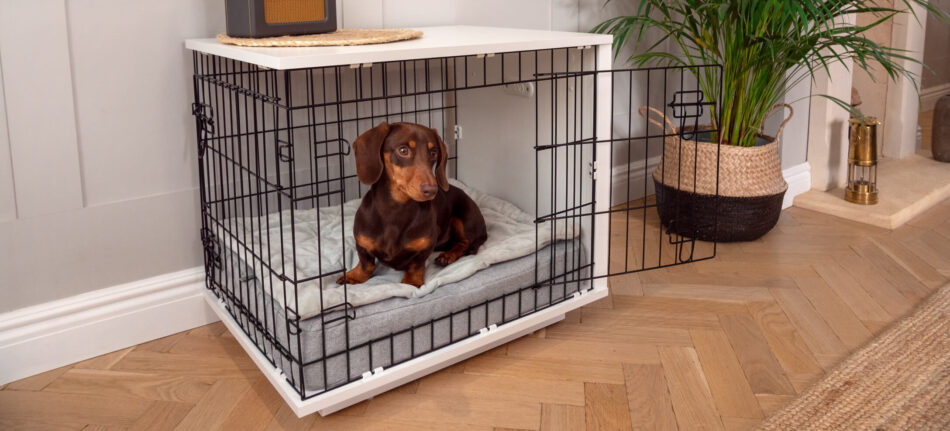
Friends or family
Having to leave the dog behind while you’re on vacation is never an easy decision, but it’s reassuring to know that you have left them with someone who you and your dog both know.
Furthermore, this usually works out as the cheapest option (depending on what rates, if any, you have agreed with the dog sitters!).
However, one issue that may come with this is that this could sometimes be seen more as a favor, so your friend might not necessarily take the role as seriously as you’d like. Therefore, it’s fundamental to lay down the ground rules from the get-go and to ensure that they can commit to looking after your fur baby for the duration of your trip.
Boarding kennels
Boarding kennels are another choice for owners who need their dogs to be taken care of while they’re away. Before opting to put your dog in kennels, consider whether their personality would match this type of environment. While some dogs have a great time during their stay and love making new friends, others, unfortunately, won’t settle in the company of other dogs, especially in an unfamiliar place that isn’t home.
If you do decide that boarding kennels are a good option for your dog, you should of course arrange a visit before dropping them off. If the kennel doesn’t allow you to look around the facility beforehand, then it’s not a wise idea to take your dog there to stay. For one, check that the kennel is clean, warm, and secure. Next, ensure that your dog will have access to their sleeping area at all times, with their own kennel unit that has enough space for them to stand up, lie down, stretch out, and turn around. You should also check that your pet pooch will be walked outside every day and that they will have toys to play with.
To prepare your pup for their stay at kennels, you should make sure that you send them with a few things that are familiar to them. For example, their favorite dog toy or blanket such as the Omlet Luxury Super Soft Dog Blanket. By doing so, you’ll help your dog to settle in, knowing that they have a reminder of you and their home!
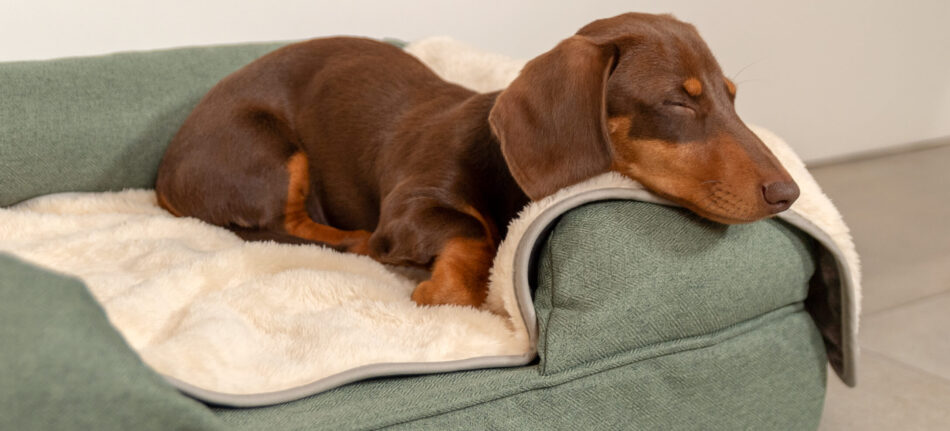
Luxury dog hotels
Feeling a little upset that you get to enjoy a vacation and your dog doesn’t?… Well, how about checking your pet pooch into a luxury dog hotel? Yes, that’s right, a hotel for your dog!
Inevitably, dog hotels are more expensive than leaving your dog in kennels, however, if you want to splurge and treat your pooch to a real taste of luxury, then a dog hotel could be the way to go! The main difference between kennels and dog hotels is the facilities. With luxury hotels, as you’d expect, you’ll often find there to be more outside space, larger rooms, or even paddling pools!
Professional dog sitter
The final main option you have for what to do with your dog when you go on vacation is to hire a professional dog sitter. This means that your pup can stay right at home, while in the safe hands of a professional.
Regardless of whether you’re using kennels or hiring a dog sitter, research is key. It goes without saying that we want our pets to be as happy and undisturbed from their usual routine as possible while you’re away. In the UK, dog sitters are not required to have a formal qualification to look after pets. However, qualifications such as animal first aid, dog behavior and animal care might be something to look out for when choosing someone, as it may be able to assure you of their credibility.
No one likes farewells with their beloved pet, even if you know that they’re going to be left in capable hands. But with a bit of preparation, you can make this time even easier for your dog! Happy vacationing!
This entry was posted in Dogs
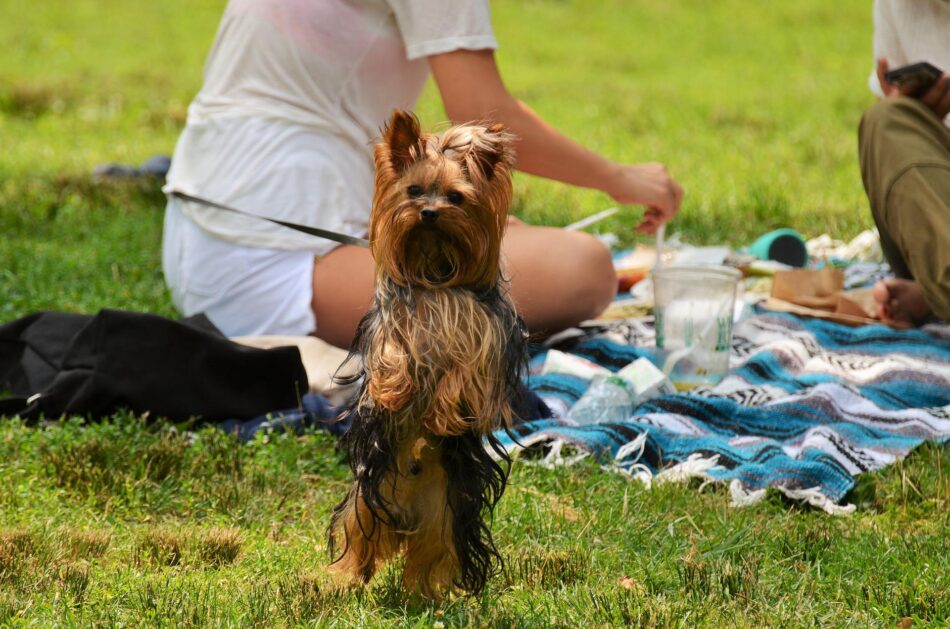
It’s the perfect time of year to set up a lovely, summer’s day picnic, and what better than to bring your furry friend along with you! But with plenty of distractions and tempting treats on display, how can you have a successful dog picnic? Here’s how you can make sure everything goes according to plan, with your pup remaining safe and on their best behavior!
Choose a dog friendly location
Before setting off for your picnic, you’ll first need to ensure that the location allows dogs, of course! While it’s easy to assume that because you’re outdoors you won’t have an issue taking your pet pooch with you, this isn’t always the case, so be sure to check beforehand.
Dog friendly picnic areas such as the woods are ideal. Not only is there plenty of shade for your dog to relax in and stay cool in, but they are often quieter zones, too.
Brush up on some basic commands
Your picnic will be more fun, and safer all around if your dog is well trained. Most importantly, your pet pooch should know how to ‘leave it’ and to ‘settle’. A picnic inevitably means that you’ll be surrounded by food, some of which might not be dog safe, as we will discuss in more detail. Therefore, they must follow your command when you tell them not to eat something they shouldn’t. If your dog hasn’t quite mastered this and doesn’t have a reliable recall, then keep them close to you on a leash. Our friends at Long Paws Pet Supplies have an amazing range of dog collars, harnesses, and leads that will make sure your pampered pooch is the most stylish dog wherever you go!
Furthermore, teaching them how to ‘settle’ will mean that you, the guests, and the dog will be able to relax during the picnic. It’s best to first practice this command in a quiet environment at home, rewarding your pup with lots of praise and a dog treat when they demonstrate the desired behavior of going over to, and staying on their dog bed or mat such as the Omlet Memory Foam Cooling Mat for Dogs. Once you’ve nailed this command at home, gradually build up distractions as your dog progresses, and you’ll be able to use their mat or bed as a prompt for them to settle outside of the house.
Staying safe with seasonal allergies
Just like us, dogs can suffer from allergies, especially this time of year. Pollen, grass, weeds, and flowers can all trigger seasonal allergies for our canine companions, so keep an eye out for symptoms such as obsessive licking or scratching in one particular area or rashes on your dog’s paws or face. Should you notice symptoms, get your pet to the vet, so that they can prescribe suitable treatment to manage their allergies before your day.

Keep your dog cool
When taking your dog outside on a summer’s day, safety comes first, so it goes without saying to take a look at the weather forecast before heading out. From 68°F there’s an increased risk of heat stroke for dogs, especially for flat-faced breeds. The ‘five-second test’ is great guidance to follow, meaning if you can’t place your hand on the pavement for up to five seconds, then it’s too hot for your dog’s paws, and they should not be walked! You can read more about keeping your dog safe in the warmer weather in our previous blogs How to Keep Your Dog Cool in Hot Weather and Can Dogs Get Sunburn?
If the heat is manageable but still warm, keeping your dog hydrated will help them to remain nice and cool on your picnic. While you enjoy a few drinks in the sunshine, make sure that your furry friend has a supply of fresh water. It’s a good idea to invest in a portable dog water bottle or bowl, which can conveniently fit into your bag and makes keeping your pup hydrated easier than ever.
Walk before the picnic
Taking your dog out for a walk before the picnic will mean that they will be more likely to be chilled out while you’re eating. A calmer dog will make for a much more enjoyable experience for everyone. That way you will know that you won’t have to keep (hopefully!) guarding your food against your excitable pup or become distracted by anything else!
Check which picnic foods are dog safe
When packing for your picnic, ensure that you are aware of what foods are not dog safe. While not an exhaustive list, the following foods can be dangerous for dogs, and should not be shared with them:
- Alcohol
- Avocados
- Cherry pits
- Chocolate
- Grapes & raisins
- Macadamia nuts
- Onions
- Peach pits
- Walnuts
But don’t worry, you can still make them feel included by packing them a dog friendly picnic of their own! If you’ve got a portable cooler bag, take along these Fruity Frozen Yogurt Treats for Dogs, which are fantastic for cooling down your pooch on a warm afternoon. Alternatively, try this pupcake recipe or these easy dog biscuits!
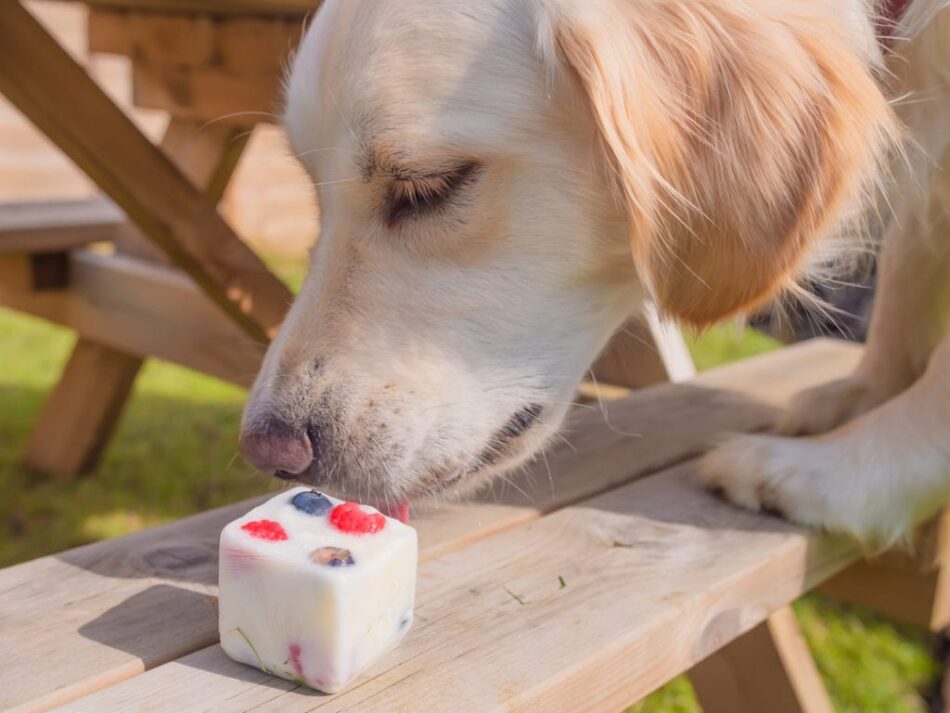
Dogs need entertainment too!
Don’t furrget that a picnic should be an enjoyable time for both you and your furry friend! You can make sure that you keep your dog occupied with their own entertainment such as their favorite dog toys for them to play with during the day. An interactive toy for example the Treat Maze Interactive Puzzle is great to take with you, offering dogs mental stimulation, as well as being a great tool for keeping them distracted from all the other exciting elements that a picnic brings.
Make sure to follow our top tips and you’ll be on your way to having the best picnic with dogs! Stay safe and have a great summer!
This entry was posted in Dogs
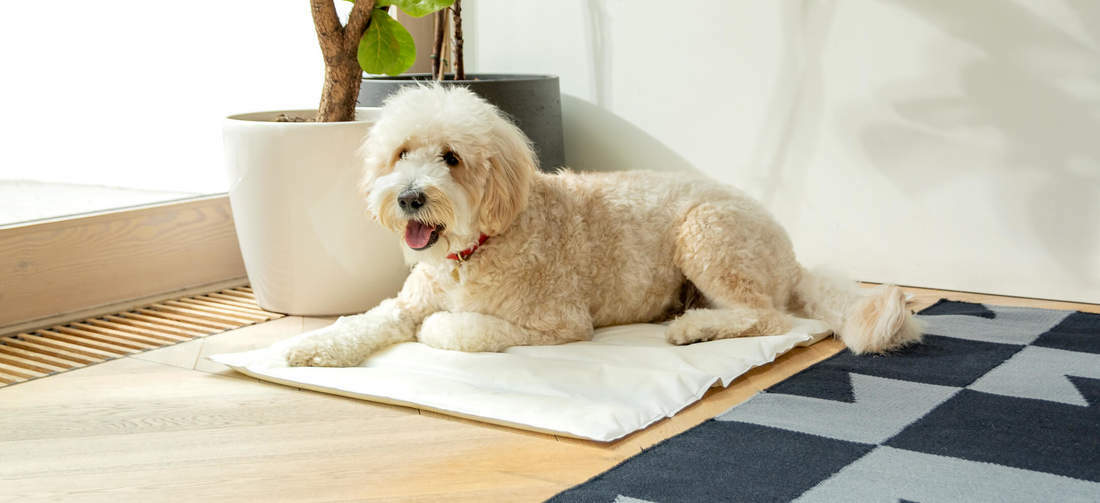
Just like humans’, dogs’ opinions on hot weather vary. Some absolutely worship the sun and will take any opportunity to find a sunny spot to lie down on, whereas others prefer to stay in the shade sipping some cold water, longing for autumn. Certain dogs are more likely to struggle with heat, including flat-faced breeds, dogs with thick coats, giant dogs, overweight dogs or dogs with underlying medical problems, so if your pooch is in a high-risk group it’s extra important to make sure he or she stays cool. Here are some ways you can help you dog beat the heat:
1. Adjust Exercise
When it’s really hot outside it’s best to stay inside during the hottest hours of the day. Your dog will still need exercise, but if possible, stick to walks early in the morning or late at night when it’s cooler.
It’s also worth trying to walk as much in the shade as you can, to avoid hot pavements and tiles, and to stop your dog from running around too much while out on the walk, maybe by keeping them on a shorter leash.
2. Keep Hydrated
Make sure your dog always has access to clean, cold water, ideally in all rooms of the house. If you’re going out, bring a bottle of water and a foldable bowl.
If you’re worried your dog doesn’t drink enough water, try feeding them things that are hydrating and have a cooling effect. Frozen fruit and veg are great, but you can also put some cooked chicken in a blender with some banana or assorted berries and freeze in ice cube trays.
3. Get On Top of Grooming
This is extra important for dog breeds with thick fur, as they particularly struggle in the heat, but most dogs benefit hugely from some extra grooming in summer. For some, regular brushing to get rid of dead hair will be enough, but others need to have their coat properly trimmed for summer.
Don’t be tempted to grab the trimmers and give your dog a buzz cut; the sudden lack of insulation can shock the dog and damage the quality of the coat, as well as make him or her feel very self-conscious! Take them to the groomers and ask what they recommend for your dog’s type of fur.
4. Go For a Dip
Having water around to cool themselves down with will be highly appreciated by most dogs. You can put a shallow kiddie pool in a shaded area of the backyard, turn the sprinklers on and watch your dog run through them, or let him or her play with the garden hose.
If you live close to the ocean or another body of water and your dog is used to swimming you can take them there to lower their body temperature in the evening. Remember that swimming can be tough exercise though, so call them back up when you’re happy they’ve cooled themselves down.
5. Keep Cool Inside
When it’s too hot to be outside, your dog will probably spend most of their time indoors, so it’s important to try and keep your house as cool as possible. It might be nice to open windows on different sides of the house to create drafts or find other ways of letting cool air circulate. Drawing the curtains or blinds will help stop the sun from heating up bedrooms during the day.
6. Avoid The Car
If possible, try to avoid going in the car with your dog when it’s hot. We all know that you should never, ever leave a dog in a car in warm weather, it doesn’t matter if the car is parked in the shade, you’ve got the windows open and it’s only for a few minutes. A stationary car will quickly get very, very hot, and it can kill your dog.
If you can choose not to go in the car on very hot days, try to avoid it, especially if your dog is not a big fan to start with.
7. Get a Cooling Mat
On a hot day, your dog will love relaxing on something cooling. The Omlet Dog Cooling Mat doesn’t require refrigeration or electricity but works by absorbing heat from your dog’s body while at the same time cooling your pooch down. The memory foam mat is foldable and super comfortable, so you can take it with you wherever you go in summer, assuring your dog will always have a place to rest that will also minimize the risk of heatstroke.
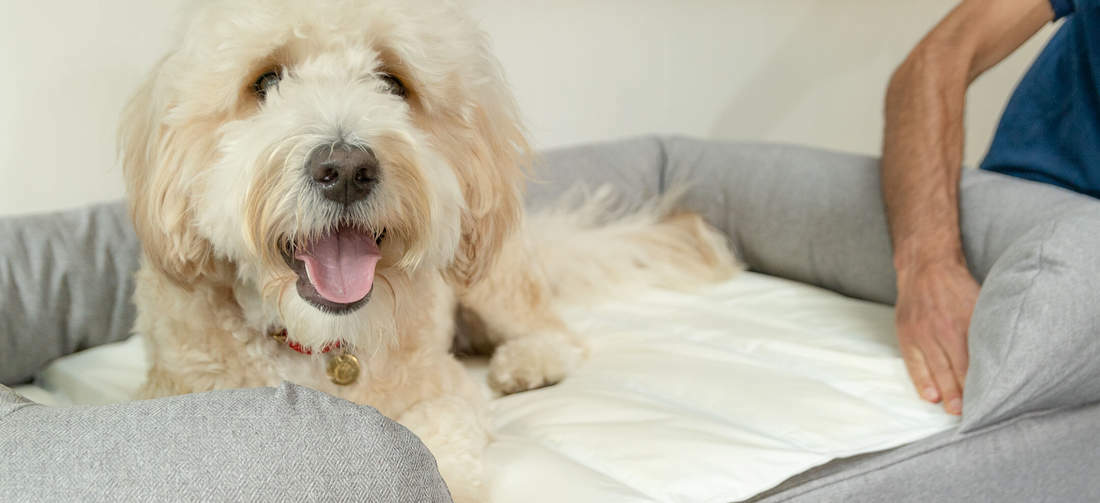
This entry was posted in Dogs
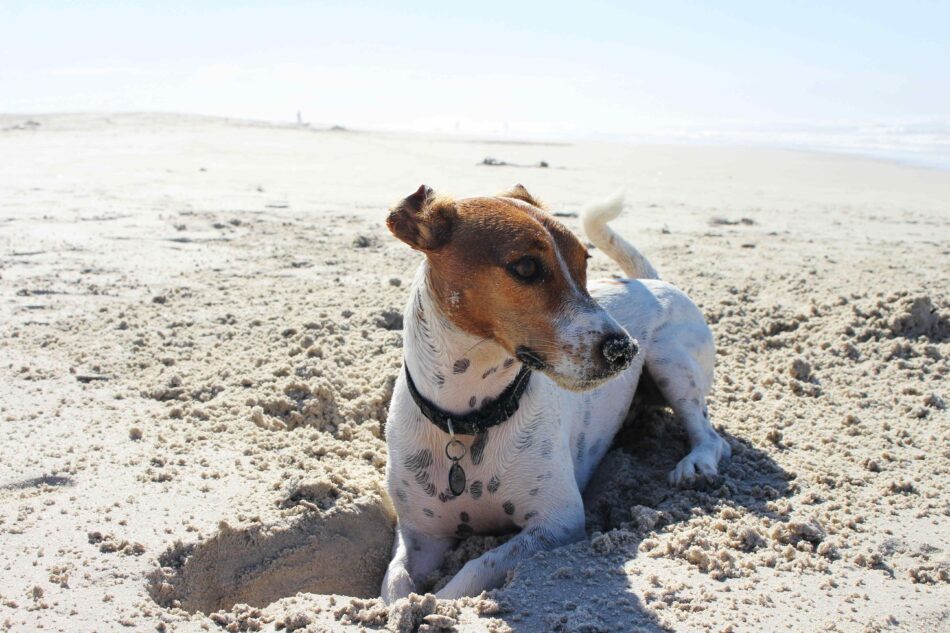
Summer is here and what better way to celebrate than with some well-deserved time off! For some, an exotic island getaway may be on the cards, and for others, a few days away camping will be more than enough to reflect, relax, and enjoy the sunshine. One thing that all dog owners will agree on though, is that our pets are part of the family. And rightly so, we want them to be included in making special memories (including vacations!) If you’ve never been away with your pet pooch before, you may be asking the question ‘Can I bring my dog on vacation?’ or maybe you’re just a little unsure how to go about organizing a trip with a four-legged addition. So, here’s everything you need to know about taking your dog on your summer getaway.
What preparation should I do before taking my dog on vacation?
First and foremost, to make your trip as enjoyable for all as possible, you should ensure that your dog is vacay-ready before setting off. This includes making sure that they’re properly trained with a reliable recall and being able to settle in their crate. Not only will having a well-trained dog make the trip a lot more enjoyable but will make it a lot safer, too.
You should also be sure that your destination is dog-friendly for your dog. Just because somewhere has labelled their property or attraction as ‘dog-friendly’, this doesn’t necessarily mean that the needs of your pet, who you, of course, know better than anyone else, will be met. Is the outdoor space properly secured? Is the property located in a particularly lively resort which could result in your dog becoming overwhelmed? Do they allow dogs of all sizes or just those under a certain weight? It’s important to have questions like these answered before going away.
You should also visit your dog’s vet, where you can check that their vaccinations and flea and worm treatments are up to date. Just like us, dogs can be affected by motion sickness when travelling. If you know this is the case for your pet, your vet will also be able to prescribe your dog medication for the journey. If you’re travelling abroad, you will also need to be provided with relevant documentation, which we will discuss shortly.
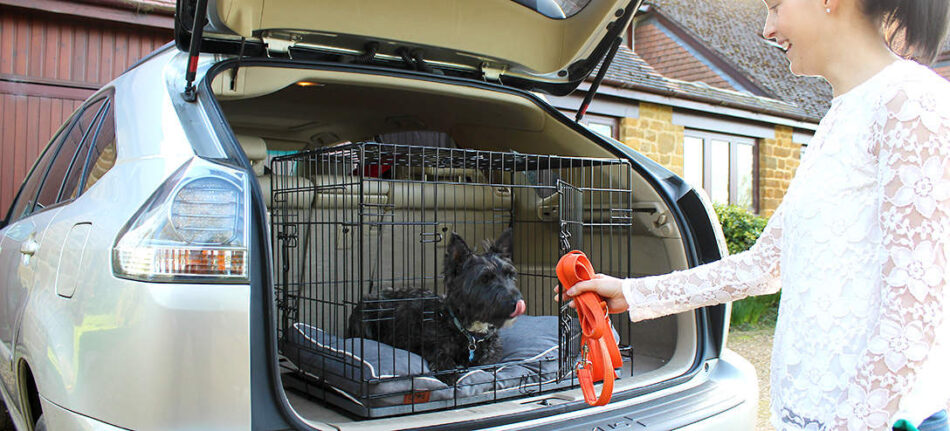
How can I travel with my dog?
Travelling by car
If you’re vacationing in the same country, the chances are that you’ll be travelling to your destination by car. Before setting off on a long journey, you’ll want to make sure that you have everything you need to ensure the ride is as comfortable and safe for everyone as possible. For one, your dog should be restrained in the vehicle either with a dog seat belt, pet carrier, dog cage or dog guard. Also, if it’s a warm summer’s day, you’ll ideally want to head out as early as you can in the morning or late in the evening when the car will be at its coolest.
During your journey, it’s important to make sure that your dog doesn’t overheat. You can help keep the car cool by keeping the windows slightly open, but not wide enough for their head to be sticking out. Alternatively, turn on the car’s air conditioning, being mindful not to have it directly blowing on your dog’s face.
We recommend making time to stop off at a dog-friendly service station for all of you to stretch your legs, for your pup to have a toilet break, and to have a refreshment (a portable dog water bottle is a great option!). When you arrive at your first stop, park in a shaded spot if it’s a warm day – this will help keep the car nice and cool for when you get back in. Needless to say, you should never leave your dog unattended in the car at any point on your travels.
Travelling by plane
When it comes to flying, the rules differ between airlines but in many cases, dogs, excluding assistance dogs, are only allowed to travel in the hold. Some airlines, however, don’t allow pets in either the hold or cabin, so please contact the airline you plan on travelling with to avoid disappointment.
Travelling by train
When it comes to travelling by train, things can be easier if you’re in NY you can bring your dog on the train if they fit in a dog carrier/bag. If your dogs are a nuisance or are endangering members of the public, then, of course, you could be asked to get off the train at the next stop. It’s also worth noting that you’re only allowed to travel with a maximum of 2 dogs.
Can I take my dog abroad?
If you live in the US airlines generally require health certificates from all shippers. So it’s a good idea to have a licensed veterinarian examine animals within 10 days prior to shipment and issue a certificate stating that the animal is in good health. These can be obtained from your vet but must be signed off by an official veterinarian (OV), so be sure that your practice provides this service. A maximum of 5 pets can accompany you unless you are travelling for dog training, a show, a sporting event or a competition, which you’ll need to provide written evidence of.
You can find more information on this by visiting the US Department of Transportation website.
Ultimately, what both of these certifications say is that your pet is fit to travel and is free of anything that has the potential to spread to other animals or humans, and has their up-to-date vaccinations, as well as yours and your dog’s information such as address, dog’s breed, pet and owner’s name.
Settling your dog on vacation
Taking your dog on vacation is as big an adventure for you as it is for them! For our pets, a new location means not only plenty of unfamiliar places but also so many new things to explore and smell. You should try to keep their routine similar to how it is back at home so that they don’t feel unsettled or stressed. For example, you should give them their food and walks at the same time as you normally would. At the same time, it’s also important to give your pet some time to settle in their new environment by letting them get enough undisturbed rest.
Taking something familiar to your dog is also a great way to help them settle. This can be their dog blanket, dog bed or a dog toy they enjoy playing with. The Nest dog bed from Omlet is perfect for travelling, as it can slide right into their crate. Plus, it’s super lightweight without compromising on comfort for any bumpy roads along the way. You can also take a dog pheromone diffuser for a more anxious dog, which can help them to stay calm.
Omlet and your dog’s vacation
Your dog’s vacation can not only be stress-free but an enjoyable trip for everyone with Omlet’s Nest dog bed, and dog blanket to offer them support in a new environment. Not heading away on summer break this year? Check out 7 things your dog needs this summer for some top tips for enjoying this season at home.


This entry was posted in Dogs

Summer is fast approaching, which means plenty of days spent outside and enjoying the long-awaited hot weather! While the season is warmly welcomed by most of us, it also means taking some extra precautions to stay safe, such as lathering up on the SPF to avoid the dreaded sunburn! Now we all know that we need to keep ourselves protected from the harsh rays of the sun, but what about our furry or four legged friends? In particular, dogs! More specifically, it raises the question of ‘can dogs get sunburn?
How do you know if your dog has sunburn?
Simply put, yes, dogs can in fact be burned by the sun as we can. Luckily, sunburn cases in dogs are often minor, albeit painful. Most commonly, symptoms include red, itchy, dry, or flaky skin and paws. Dogs are most likely to get burned on body parts that have been exposed to UV rays such as the tip of their tail, nose, ears, belly, and around their mouth, so you should pay particular attention to these areas if you suspect a burn.
Most cases of sunburn peak at 3 days after exposure, but more severe cases can also lead to lethargy and blistering on the skin, which can take two weeks to heal. Affected dogs may additionally demonstrate signs of being in pain when you go to pet them as well as developing a mild fever.
How can you treat dog sunburn?
While prevention is always better than the cure, there is a solution should you find your dog has been burned after a day out in the sun! For minor burns, there are an array of methods you can use to soothe your pup’s burn, but they don’t actually help with the healing process. Nonetheless, these should not be dismissed as your dog will appreciate a much-needed relief from their pain. Examples include using a cold compress or giving your dog a nice, cool bath. Alternatively, oatmeal baths are a great idea, whereby your dog can soak for 10 minutes, as you massage the oatmeal into their fur, before rinsing off with warm water. To heal burns, both aloe vera gel and vitamin E are perfect, with both of course being pet safe.
If your dog’s symptoms do not improve following the use of home remedies, and you are at all concerned about the wellbeing of your pet, please do not hesitate to speak to your vet, who will be able to offer you medication.
How to protect your dog from sunburn
Fortunately, keeping your dog safe from the sun and sunburn is hassle-free! Just as we stay protected from the sun, some dogs also require sunscreen (we even included it as a must-have dog product in our 7 Things Your Dog Needs This Summer blog!). It goes without saying that you should only use dog-safe sunscreen, ideally with an SPF of at least 30. Most importantly, do not use sunscreen that contains Zinc Oxide or Para-aminobenzoic (PABA).
To further reduce the chance of your dog getting sunburned, you should walk them during the early morning or late evening and stick to shaded areas as much as possible. And after a stroll outside, what better than for your dog to come home to relax on their very own Memory Foam Cooling Mat for dogs! Omlet also has a wide range of Dog toys to keep your furry friend entertained indoors over summer!

How to apply dog sunscreen
To apply sunscreen to your dog, funnily enough the process isn’t all too different to how you would apply it to human skin! Simply pop some sunscreen on your fingers and rub into your dog’s coat, making sure to pay particular attention to the exposed spots we mentioned earlier. Essentially you should apply in areas mostly to areas that are not covered in much fur.
Take extra care when applying sunscreen around their eyes, and once done, leave it to soak into their skin for around 15 minutes. Just be sure to reapply the sunscreen every 4 to 6 hours and to keep a close eye on your dog during soaking time to ensure they don’t lick off the cream!
What dog breeds are most susceptible to sunburn?
If you’ve got a dog with thinner hair or a paler coat, then this makes them more susceptible to getting sunburned compared to other breeds. Examples of this include Greyhounds, Chinese Crested, and Dalmatians to name a few. This, however, is still not to say that other breeds cannot get burned at all, so you should still take precautions such as using sunscreen and keeping them out of the sun for sustained periods of time to ensure they remain protected.
To find out more about keeping your dog safe during this season take a read of our previous blog post How to Keep Your Dog Cool in Hot Weather and enjoy your summer sunburn free!
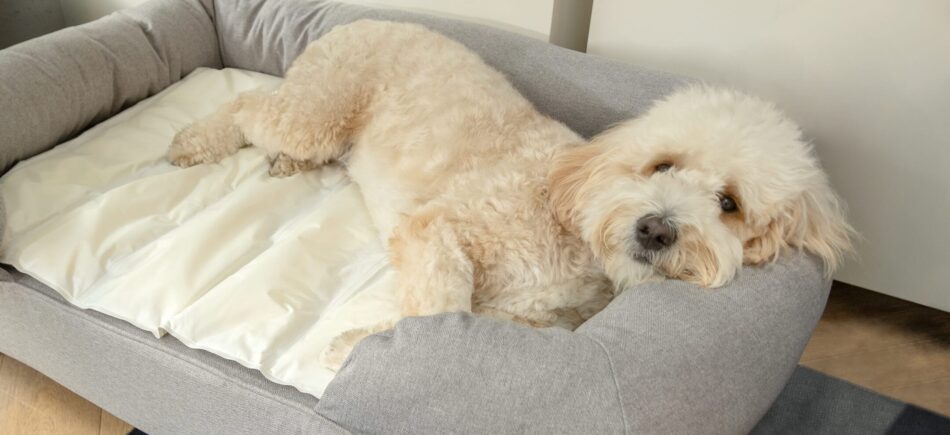
This entry was posted in Dogs
Summer is nearly upon us, which means plenty more time to be spent outside with our feathered, fluffy, and four-legged friends! While the rising temperatures and longer days are enjoyable (for most!), it’s important to take the right measures to keep your pup cool to prevent them from overheating. Here’s 7 things your dog needs this summer to stay safe this season!
1. A cooling mat
Number 1 on the list of 7 things your dog needs this summer is a cooling mat. Over this season, your dog will really appreciate something that they can relax on, which will also help them to cool down. Omlet’s Memory Foam Cooling Mat For Dogs is perfect for just that, and with it being foldable and lightweight, you can take this must-have summer accessory just about anywhere! The mat doesn’t require any refrigeration or electricity and works by absorbing heat from your dog’s body, minimizing the risk of heatstroke by keeping your pet cool for up to 3 hours.
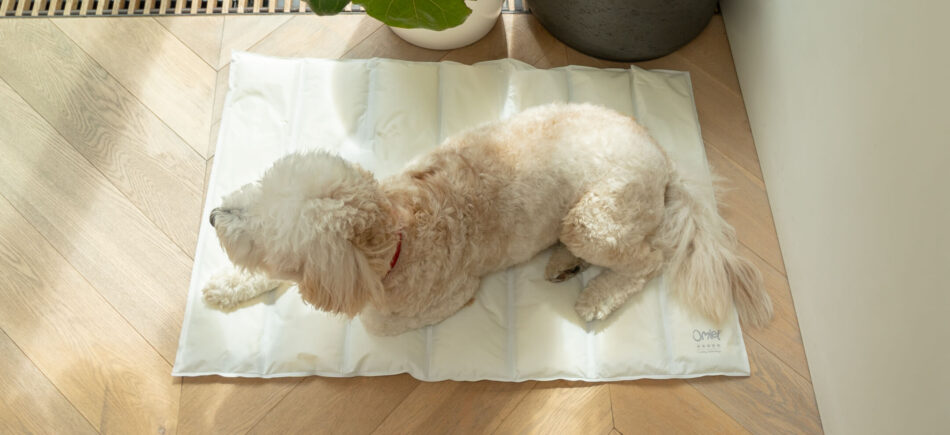
2. A portable dog bowl
Your dog should have access to clean, fresh water at all times when they’re at home. However, one of the 7 things your dog needs this summer is a portable water bowl (and water!). You should take this with you on walks or when travelling in the car to ensure that your pet stays hydrated.
3. Frozen treats
Just as we love a nice, cold ice pop on a warm afternoon, so do our pet pooches! Try these delicious Fruity Frozen Yogurt Treats for Dogs that will be bound to refresh your pup down on a hot summer’s day! These are super quick and easy to make, and only require Greek yogurt, water, and a selection of dog-safe fruit.
4. Frozen toys
Similarly, it’s a great idea to freeze some of your dog’s toys over the summer as another way to not only keep them mentally enriched but also to keep their body temperature down! The best kind to freeze is a chew toy such as a Wild One Bolt Bite toy, that can first be filled with peanut butter before freezing to occupy them for even longer.
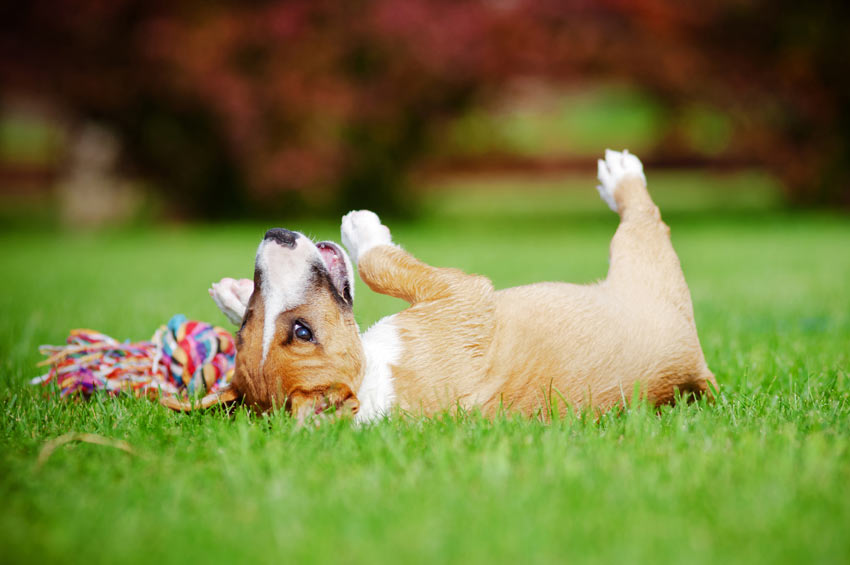
5. Dog sun protection
Believe it or not, our furry friends too can do with a bit of help from some sun protection in the form of sunscreen. Just like us, dogs who are exposed to the sun for a long period can get sunburnt, with breeds such as Dalmations, West Highland White Terriers, and Greyhounds more likely to be affected than others due to their paler coats or thin hair. Therefore, it’s a wise idea to top up on some sun protection cream over the next few months. Simply apply dog sunscreen to the thinner areas of your dog’s skin around 20 minutes before going out and reapply throughout the day.
6. Flea and tick prevention
Fleas thrive in warm, humid climates, so you’ll need to be sure that your dog is up to date with their treatment before summer arrives. Furthermore, if your dog will be spending more time in the great outdoors, roaming through long grass, also makes them more susceptible to fleas and ticks. Fortunately, Omlet has effective dog flea and tick products that are both effective and easy to use to keep these nasty parasites away!
7. A suitable car restraint
Summer inevitably means that many of us will be travelling around more with our dogs, be it a day trip to the park, or a week-long staycation! Take a look at dog travel accessories to find a suitable option to help your pet travel safely.
Please note that most importantly when travelling with your dog, you should never leave them unattended in a car. In fact, when it reaches 71°F outside, inside the car temperatures can quickly reach 116°F! As you can imagine, this can be detrimental for a poor dog.
It goes without saying that as fun as summer is, you should be careful and put your pet’s safety first so that it can be enjoyed by all of us!
This entry was posted in Dogs
In the month of May, we’re answering all your microchipping questions, from, do dogs have to be microchipped, when a puppy should be chipped to how to change the information on the microchipping database to make sure you keep all your details up to date.
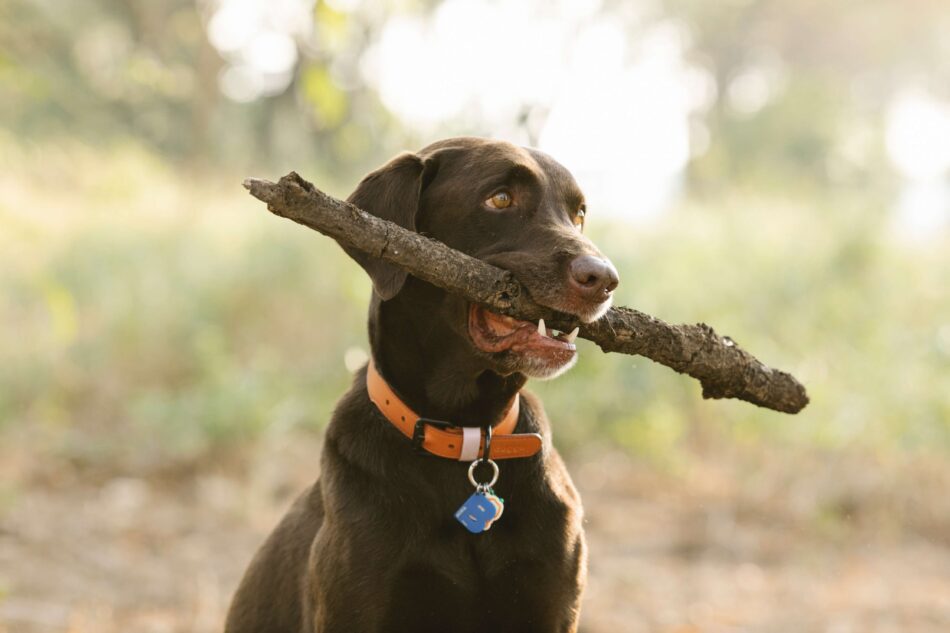
Do dogs have to be microchipped?
As of right now in the US, microchipping is defined by each state. In 2020, the senator of California introduced a bill to senate to say that if an owner is not found for any homeless cats or dogs that are picked up by animal control they will be microchipped by the humane society or rescue in the appropriate area.
According to the Starwood Animal Transport Services when travelling with your cat or dog by air in the US it is also part of the entry requirements. Failing to provide this information could mean your pet is refused entry. There may be some exceptions to the law for some owners if their dog is very old or in poor health, though this would require an exemption certificate from a vet.
The microchipping law is there for the safety of your pet and also others, even though it may seem like something out of a dystopian novel. Unfortunately, for the many dogs that are picked up as strays that don’t have a microchip, the rescue centers have no way of knowing who these beloved animals are or who they belong to. For many local authorities, dogs will remain lost or considered a stray for up to 5-7 days and then they are handed over to dog sanctuaries and rescue centers to be rehomed.
The information recorded on the chip will be able to identify your pet to others based on medical information, age, name, address, and details of their pet parents. It really is an important part of being a responsible dog owner.
What is a microchip?
Think of a microchip as a form of ID, like a passport or driving license, but for dogs. Our doggies can’t exactly communicate this sort of information themselves! Although a collar with an ID-tag with up-to-date contact details has all the necessary information, these could easily be removed, or could fall off.
A microchip is a computerized chip containing a unique 15-digit number that will be visible when scanned by a microchip reader. It is the size of a grain of rice and is inserted under the skin around the scruff of the neck between the dog’s shoulder blades with a needle. The chip will contain the owner’s details and a unique code that is specific to your pet.
Will my puppy be microchipped before I take them home?
In preparation for the arrival of your new pup, you need to ensure that your home is ready and that the right safety precautions are in place, toys and food are ready and a snuggly sleeping area is taken care of because your puppy will be doing a lot of sleeping to start with! It is important to understand the daily care of a dog when taking on a new puppy.
We would recommend the Bolster Dog Bed for puppies. The bolstered sides around the bed will provide a little safe barrier to keep your pup in place and stop them from falling out. The covers are removable and washable which is incredibly handy with such a youngster around!
Puppies cannot be sold until they are at least eight weeks old, by which point, as the new law states, puppies must be microchipped. Some vets will recommend that very small breeds like a chihuahua are microchipped when they are a bit older or bigger but contact the vet to see if this is the case and arrange an appointment for this simple procedure.
The breeder will register the puppy on a national database and the breeder’s details will forever be associated with the microchip. It will also include the keeper’s information which can be changed or updated if the information changes or the dog gets a new owner.
You can make sure your puppy is microchipped by asking your local vet or the breeder themselves. They will use a scanner that reads the chip and identifies the information.
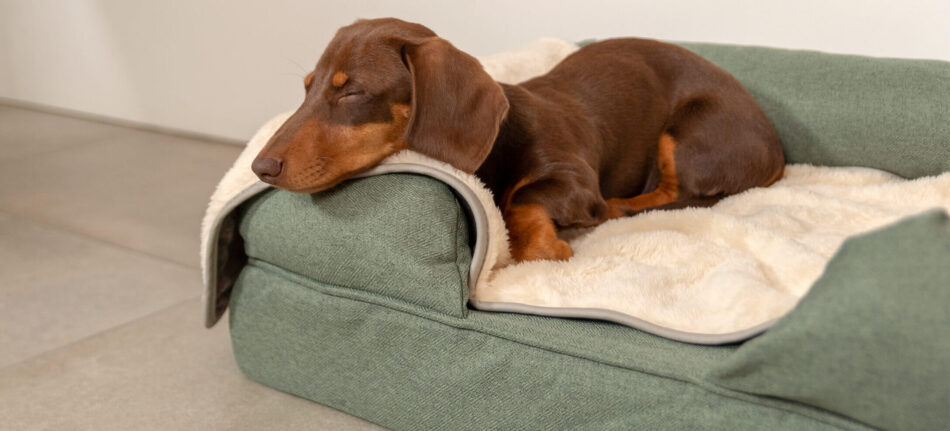
Is my dog’s microchip proof of ownership?
The details of the microchip are registered through an approved database, not through the government. A person is considered to be a ‘breeder’ if they’re the owner of a dog that gives birth. The person who acts as the primary caregiver will register as a “keeper” rather than an owner of the dog. The keeper does not provide proof of ownership, however, the keeper will have a legal responsibility for the dog, so if the dog strays or causes injury, they will be held accountable.
If for whatever reason you have had to pass your dog over to someone else because you are unable to take care of them or are moving away, then it would be your responsibility to ensure that the new owner is given the correct microchip registration paperwork so that they can update the details themselves.
Who is responsible for microchipping a puppy?
When it comes to microchipping, it is the responsibility of the dog breeder to ensure that all puppies are microchipped before they are rehomed.
If you are considering a rescue puppy rather than going through a breeder, the animal sanctuary will be responsible for updating the details of the dog and new keeper.
How do I change my dog’s microchip details?
When your dog’s identity chip is registered on a database you will receive a notification to confirm the details are correct and you will be given a microchip number. This information can be checked by contacting the database itself. You should also contact them if you, for some reason, need to change the details. There is a small fee associated with these administration changes, but it’s imperative that the information is correct in order to make sure that the chances of you being reunited with your pet if they go missing are secured.
If you are unsure which database your dog’s chip is registered with then you can get this checked by your local vet.
What happens if I don’t get my dog microchipped?
In an attempt to eliminate strays roaming the streets, dog theft, and putting immense pressure on animal sanctuaries and rescue centers it is the responsibility of the dog owners to make sure that their dogs are chipped and that the details are correct.
Why should I get my dog microchipped?
If your dog goes missing and is found not to have a chip, then the chances of them being reunited with their pet families are very unlikely. Your dog wearing a dog collar with an id-tag is simply not enough. This will give you peace of mind knowing that if anything were to happen to your dog it could be returned to you!
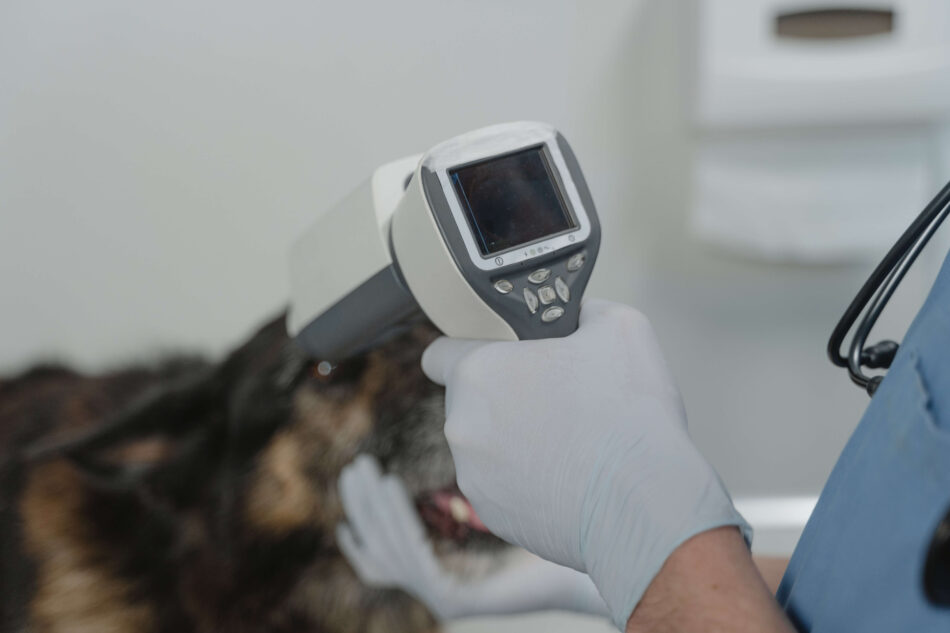
What if my dog’s microchip doesn’t work properly?
A microchip is designed to last for the duration of a dog’s life, however, like with all things to do with technology, there is always a potential for them to fail or not work properly.
If for some reason the chip details are incorrect, or it is not working properly you would need to contact the database itself or visit your vet who will be able to check to see if the chip is working and attempt to diagnose the problem.
Where can I get my dog microchipped?
Vets and dog breeders are the main organizations that provide a microchipping service, but it can also include registered dog walkers and groomers, as well as some animal charities.
How can I find out if my dog is microchipped?
If you have any concerns about whether your dog is microchipped, then the best thing to do would be to visit your vet who will be able to scan the dog to check if there is an implanted chip. If that isn’t possible then other members of the dog lover’s community such as a registered charity would be able to help.
How can I check my dog’s microchip information?
This information can be obtained through a database, or your country’s equivalent. Dog owners will have a microchip number as part of the registration process and the relevant paperwork. This way, you will be able to access the information easily through a registered database.
Can microchipping hurt my dog?
As a dog lover, the last thing you want to do is hurt your dog, but microchipping is a very quick and simple procedure, even if it does involve a needle! It may cause some slight discomfort to your dog, but it will soon pass. It should be seen as a simple standard vaccination, which in the long run will protect your dog and keep them safe.
How old is a dog to be chipped?
This is done from when they are eight weeks old. If in some cases, the puppies or dogs have been rescued from illegitimate breeders then the registered charities will ensure that they are chipped.
How much does it cost to microchip a dog?
The average cost of microchipping your dog is arpund $50 in the US and this is a one-off fee for the implantation of the chip. Some charities will offer this service for free. If you need to change the details of the chip at any point, then there will be a small fee through the database that the chip is registered.
This entry was posted in Dogs
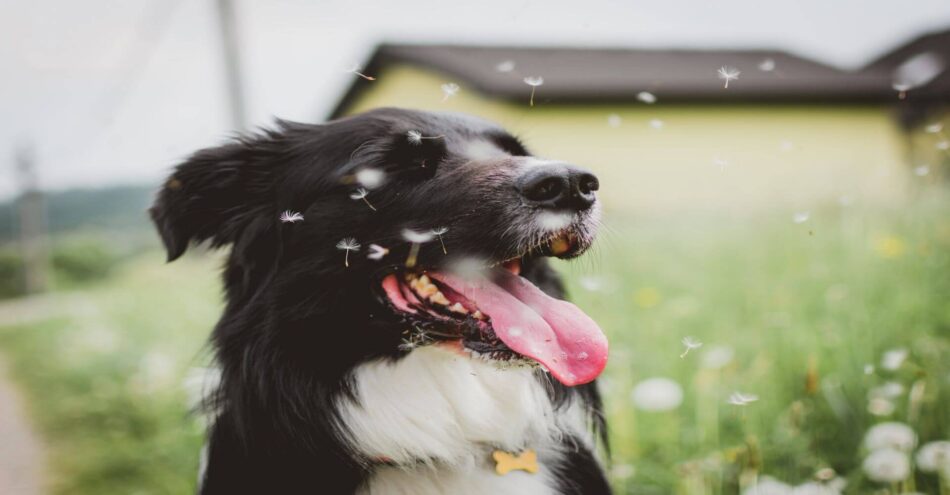
Common allergies in cats and dogs have been identified as 3 main allergy groups, which we explore in this article. Some common allergies are seasonal, and others can creep up throughout the year. Understanding the common allergies in cats and dogs will make being a pet owner easier as you know what to look out for and how to handle it. Allergies can be treated quite easily, but there are a few symptoms or warning signs that we can look out for to make sure that our cats and dogs are healthy and happy.
Persistent seasonal allergies such as the dreaded hay fever kicks in for many of us humans, but we know that we are not alone in this seasonal battle of the bugs as our beloved pets can suffer too. We exhaust alternative medications, home remedies and whatever we can lay our hands on to try and keep these pesky allergies at bay!
Despite doing our absolute best to ensure our cats and dogs are spoiled and looked after, sometimes we cannot always spot the potential threats of allergies or illness.
Allergies in cats and dogs fit into 3 main groups. These groups make it easier to be able to narrow down and identify the cause and then the form of treatment that is required. Whilst you may be able to “self-diagnose”, (we all like to play doctor or vet with a quick google search), it is always recommended to check with your vet before attempting any medicated treatments yourself. However, a little research and a general understanding of what you could expect as a pet owner are perfectly normal.
Common Allergy Groups in Cats and Dogs
1. Flea Allergy
This is probably the most common allergy and one that most pet parents are aware of. Cats and dogs will react to the toxins in the saliva following a flea bite, which will result in a reaction on the skin.
Cats will over groom to the point where it’s very noticeable and the skin develops crusts all over the body, known as miliary dermatitis. Dogs tend to nibble and scratch at the affected areas and the skin will develop little red spots.
2. Food Allergy
Food allergies don’t necessarily show up immediately, they could manifest from eating the same food over a long period of time. It is a reaction to a specific protein or chemical in the food, which then appears on the skin. Common proteins which can cause allergies for both cats and dogs are chicken, fish, gluten and egg.
A common symptom of food allergies in cats will be persistent scratching around the head and neck. Symptoms in dogs are not as easy to identify but generally if scratching is more regular and your dog’s skin seems more irritated then it could be a sign of a food allergy.
3. Atopic Dermatitis
These are allergies caused by the environment, similar to hay fever or asthma in humans. They can be seasonal like an allergy to pollen or all year round, for example dust mites. With dermatitis, the skin will be visibly irritated and affected with symptoms including the following:
- Constant scratching in a particular area
- Flaky skin
- Red or irritated skin
- Over licking
- Chewing
- Fur loss
- Patchy skin
- Skin rashes or spots

Should my pet see a dermatologist?
If you think your pet is suffering from an allergy with any of the symptoms mentioned, you will notice that the skin is affected. A dermatologist will try to recognize the cause of the skin irritation by discussing your pet’s history, for example diet, home life and behavior. Once they are able to identify the correct allergy group, they will be able to perform certain tests to pinpoint the exact cause and recommend any treatment or ways you can help.
Seasonal Common Allergies in Dogs
Seasonal allergies can affect your canine friends in very similar ways to humans. They could be affected by environmental allergens like dust mites, fleas, mold and pollens from grasses, trees, weeds, and flowers. They will not hide their discomfort and will most likely obsessively lick or scratch one particular area. Pay close attention to their bellies, paws, armpit, ears and face. During the seasons of irritation, keep your home as clean as possible and free of mites and pollen. The Topology Dog Bed provides a simple and stylish way to keep your doggy comfortable all year round with easy to clean removable and washable covers.
Seasonal Common Allergies in Cats
Cat allergies are not as common as they are for dogs, though some will display irritation from pollen or bites from fleas. If your cat sneezes a lot then it could have an allergy to pollens. As with dogs, it’s important to make sure their bed is kept clean. A good alternative is the luxury Maya Donut Cat Bed, which has a removable cover that can be washed in the machine.
Respiratory Allergies
Respiratory allergies are far less common in cats and dogs, but they can suffer from them. Symptoms are similar to those of a cold, including watery eyes, runny nose, coughs and yes, even sneezes! Some respiratory allergens could develop into asthma. This could occur from being in a smoky environment, building debris, chemicals or certain cleaning products or pollution.
Pets, like humans, benefit from fresh air, so taking dogs for regular long walks will always be good for them (and you). While you may want to take your cat for a walk, maybe it’s time to consider an Outdoor Catio, which will not only provide a safe space for your feline, but it will also provide them with plenty of space to play and explore and generally keep fit!
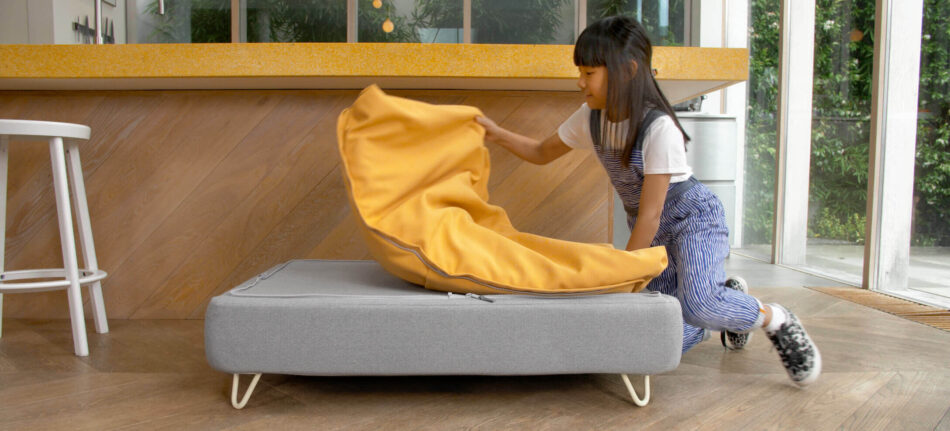
Conclusion
Being a pet parent comes with worries, but also plenty of love, laughter and snuggles along the way. Medically treating your cat or dog can be incredibly difficult to do because you don’t want to be the one that causes them any discomfort or pain, but sadly sometimes it is part of the job description and absolutely necessary to ensure they live a long and healthy life.
If you do suspect that your pet is suffering from any allergies, it is important to talk to your vet and run any concerns you have by them. Most allergies can be treated easily with medication, a change of diet or simple TLC. When dealing with allergies it is important to keep your cats and dogs home clean and you may need to adapt or change your routine to suit their needs.
This entry was posted in Cats
While the demand for buying puppies drastically shot up over the pandemic, there was also a significant rise in those rescuing dogs from abroad. So much so that according to the Human Animal Infection and Risk Surveillance Group, 2020 saw a 51% increase in importing dogs from Romania to the UK alone! But with so many of our pet pooches now being rescued from across the globe, it’s left many pet owners scratching their heads as to what their dogs are exactly! As a result, doggy DNA testing has also soared in popularity, providing pet owners with an easy and convenient method of finding out more about their dog’s genetic makeup. So how does doggy DNA testing work?
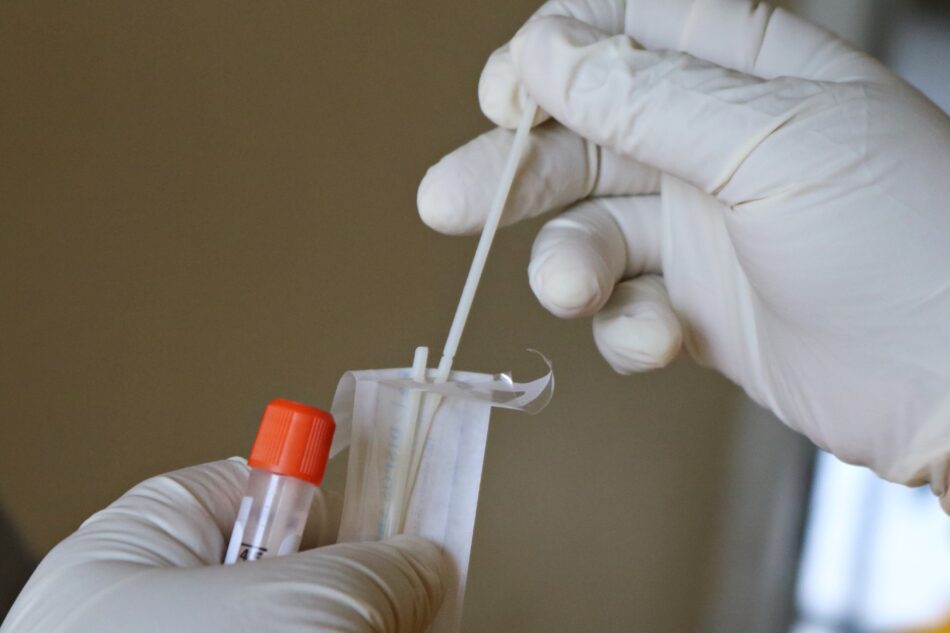
Why Get a Doggy DNA Test?
Dog owners choose to get doggy DNA tests for several reasons, with the most obvious being curiosity! While owners can have some sort of indication of what breed their dog is from either the rescue center or by their physical appearance, it can be tricky to know for sure. Therefore, testing your dog’s DNA offers a much clearer, nearly entirely accurate, answer to this.
Furthermore, having an understanding of what breed a dog is, may provide owners with a better understanding of their dog’s behavior. Similarly, this can also help dog parents gauge an idea of potential exercise requirements or what size their puppy will be when fully grown. It will be helpful to read our 5 Ways To Figure Out What Dog Breed Is for You and Best Dog Breeds for First Time Owners blogs, which will give you some further information on breed-specific behavior. Regardless of your dog’s breed, age, or exercise requirements, Omlet also has a wide range of fun and stimulating dog toys to meet their needs!
Alternatively, a dog DNA test may be for breed confirmation for pedigree pups i.e. confirmation that a dog is purebred, as it was sold. Shopping responsibly from reputable breeders is fundamental when buying any dog, however, should a dog begin to demonstrate traits of, or appear as, a mixed breed dog, many owners inevitably would like some clarification. This being said, a doggy DNA test for this may not be completely accurate…
How Accurate Are Doggy DNA Tests?
Common questions regarding this subject are whether dog DNA tests work and how accurate they are. Doggy DNA tests have accuracy rates anywhere between 93% and 99%, but this depends on which specific test you purchase. Generally speaking, however, the more you pay for your test kit, the more accurate it will be.
Genetic markers (used to identify DNA sequences) are one challenge when it comes to how accurate dog DNA tests are. Some testing companies are not able to test for as many genetic markers as others. For example, testing may detect whether a dog is a carrier of a specific health issue or themselves has this issue. However, the fewer genetic markers a manufacturer can test, the less accurate the information they will be able to provide you with.
Furthermore, if using a DNA test to determine whether your dog is purebred, you may be left disappointed. A reason for this is that many purebred dogs have been cross-bred over time to help with health problems that are associated with specific dog breeds. So even if everything otherwise says that your dog is purebred, the result may not reflect this.
How is a Dog DNA Test Done?
So, exactly how exactly does doggy DNA testing work? A dog DNA test, also known as a genetic test, is conducted similarly to how human DNA tests are. Put simply, a DNA test works by checking a DNA sample via a cheek swab, extracting DNA from saliva, which painlessly collects cells from inside of your dog’s cheek.
When you buy your dog’s DNA test it should come with simple instructions on what you need to do. However, the basic procedure is to first remove the swab from the tube you will receive in the doggy DNA test. Next, swab your dog’s cheek by gently rubbing around the inside of their mouth for usually up to a minute, before removing the swab and placing it back into the tube. After obtaining the sample, you’re ready to send off your test to the manufacturer to get the test results! Of course, with any testing, user error can occur. Therefore, reducing the accuracy of results, but it’s a generally very easy process.
How Quickly Can You Get Results?
How quickly you can get your dog’s DNA test results really does depend on what test you have bought. Some tests can provide DNA results in just two weeks, whereas others can take up to two months. When looking into dog DNA test kits, this is a factor to consider, so look into testing companies that can offer a fast turnaround time if you need results quickly.
Can You Get A DNA Test For Cats?
Pet DNA tests can also be done for other animals such as cats! However, it’s not quite reached the popularity that dog DNA testing has just yet. This is mostly for the reason that it’s incredibly difficult, in fact nearly impossible, for a cat DNA test to provide you with an accurate breakdown of their breed. It also goes without saying that depending on your cat’s temperament, obtaining the saliva sample itself might be a little more tricky!
Where Can You Get a Doggy DNA Test?
Interested in doing a doggy DNA test? These can either be purchased online or carried out at the vet. There’s an abundance of kits on the internet, so be sure to look at verified reviews for the best accuracy and result time before making your decision!
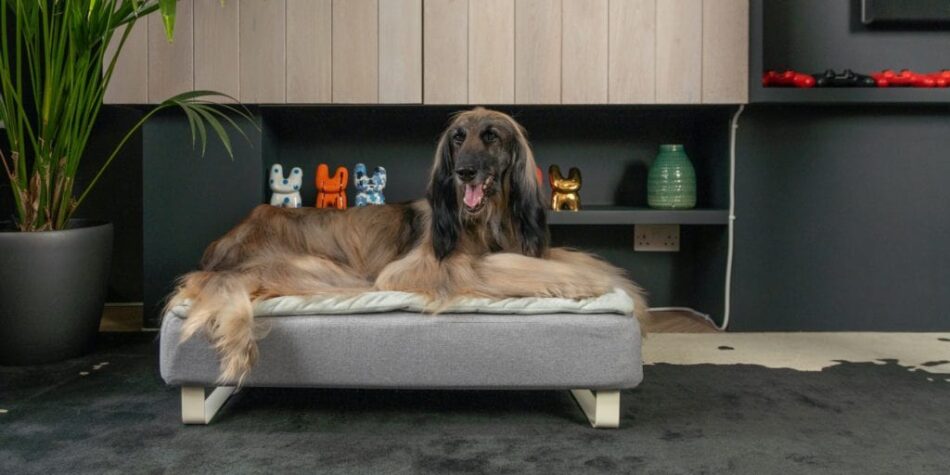
This entry was posted in Dogs
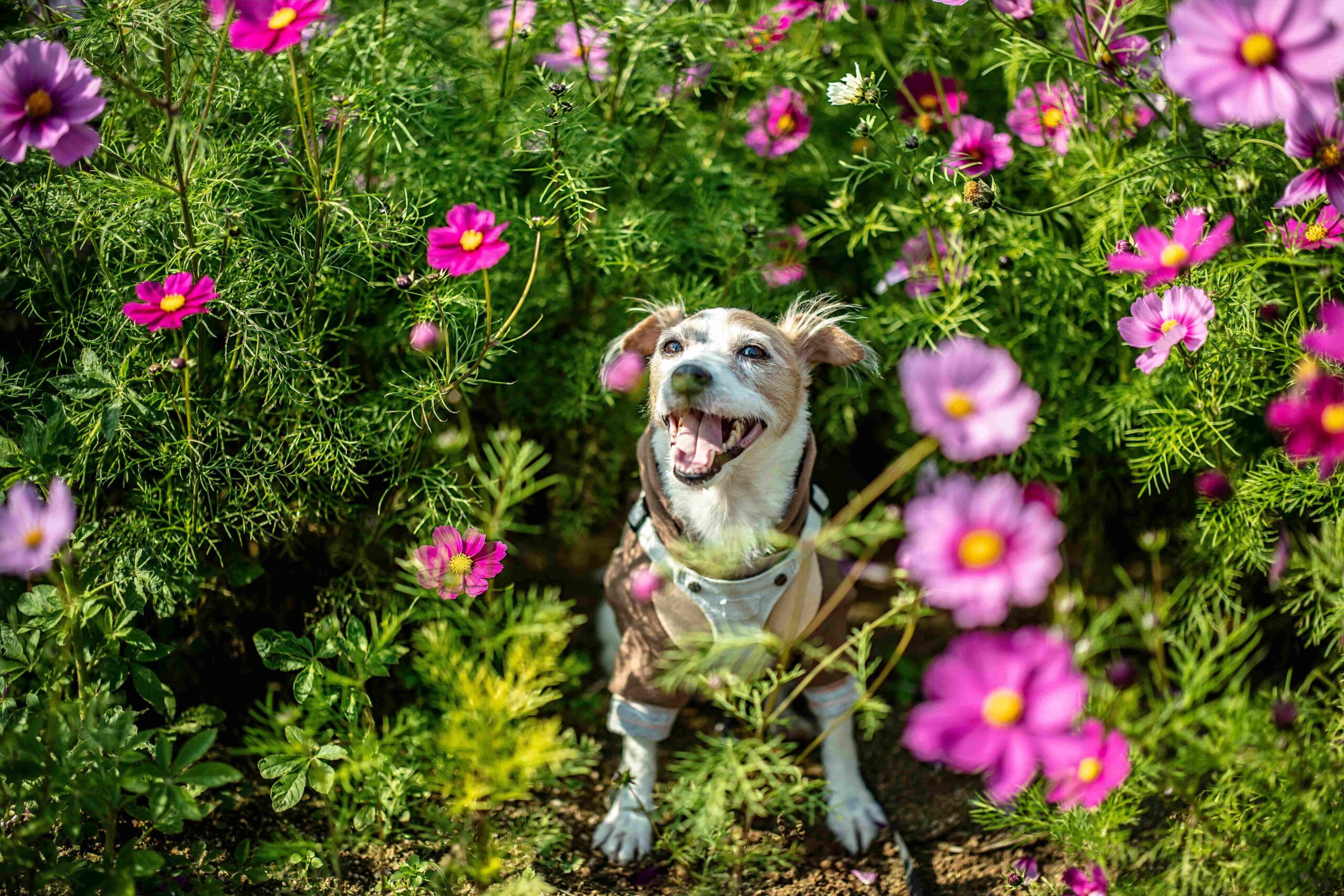
Spring is the ideal time for a fresh start! Whether that means having one big clear out, starting a new project, or getting organized, it presents the perfect opportunity to have a bit of a change! So why not get your cat or dog involved with your spring overhaul so that they can start the new season in tip-top condition! So, how do you begin a spring clean of your cat or dog’s life?
Remove Pet Hair from Around the Home
Before making a start to your cat or dog’s own spring clean, grab the supplies and get to work on removing any pet hair or dirt from around the home. Many pet parents will agree that getting rid of animal hair from around the house seems to be an impossible task, especially if you’ve got a cat or dog that sheds a lot.
However, there’s no need for harsh chemicals when cleaning the house with pets. For your carpets, a top tip is to sprinkle down some baking soda before vacuuming. Not only will this help to remove hair, but the baking soda will minimize odors. Just be sure to use a vacuum that has been specifically designed for dog and cat hair to make things a bit easier!
When it comes to cleaning fabric sofas, you can simply use a dry sponge, and this will pick up any cat or dog hair lying around. For more household cleaning tips with pets, you can read our previous blog Cleaning Tips For Dogs Who Love Mud!
Using a pet blanket on top of beds and sofas, however, is the best way to keep your furniture protected in the first place, as well as providing your pet with a cozy spot to relax.
Clean Your Pets’ Beds
Now that the household spring clean is complete, it’s time to focus on your pet, and a great place to begin is by cleaning their bed. We wouldn’t like to sleep on a dirty mattress, so neither would our pets. And with dogs sleeping between 13 and 14 hours a day, and cats between 12 and 16, it’s fundamental to provide them with a clean, secure, and safe place to rest. Fortunately, all Omlet beds are conveniently easy to clean, with removable covers and toppers that are machine washable.
Alternatively, treat your cat or dog to a new bed this spring. For cats, the Maya Donut Bed comes in a wide range of colors that can add a touch of spring freshness to your home for the season. The Topology bed is perfect for dogs, with the option of raised feet, which improve home hygiene and airflow.
Give Your Cat or Dog a Groom
Spring cleaning wouldn’t be complete without a bit of a pet makeover! Well, not necessarily a full head to paw transformation, but a good bath and brush go a long way! Depending on the breed of your dog or cat, they might need to make a visit to the groomers, but it’s a good idea to keep on top of a basic regime at home. Furthermore, grooming is not only for your dog or cat’s appearance but is also important for your pet’s health by aiding with keeping their skin healthy and preventing fleas or ticks for example.
Treat Your Pet to Some New Toys and Outdoor Entertainment
Spring means some warmer weather is on the way, so both pet owners and our furry friends will be spending much more time outside. A few new toys will be greatly appreciated by your cat or dog, as they adjust to the new season after spending a lot of winter cozied up indoors. Or how about treating your cat to their very own outdoor cat run, which is perfect for indoor and outdoor cats alike, who love adventuring but need to remain safe in the garden.
Prepare for the Heat
Before we know it, summer will be here, so why not get prepared as early as possible by giving your pets the best chance of staying protected from the heat. Something to invest in during spring is a cooling mat for your dog. The Omlet Memory Foam Cooling Mat has a non-toxic self-cooling gel inside, meaning that the mat doesn’t require any refrigerating. You can place your pup’s mat either on a flat surface or on their bed and they’ll stay nice and cool for up to three hours – the perfect summer accessory!

The Omlet Cooling Mat is super easy to clean, with a quick wipe down!
Spring is just around the corner, so there’s nothing stopping you from beginning your tidy up from today! Before you start cleaning your home, however, it goes without saying that any cleaning products you use in your house should be pet-safe, so always make sure to check the labels. How will you be spring cleaning your cat or dog’s life?
This entry was posted in Cats

Winter is here, and the chilly weather means that our pets could all benefit from a bit of our help to try and keep snug. As a dog owner, you may be wondering what exactly you can do to keep your dog warm this season. How about investing in an extra cosy dog bed? Or maybe you’ve considered buying them a jacket for them to wear on walks? But have you ever thought about getting your dog their own blanket?
Will all dogs benefit from a blanket?
Some dogs struggle to regulate their body temperature more than others, which means they need extra warmth from a blanket, especially in the colder weather. Older dogs, in particular, have a weaker immune system and are more likely to develop joint pain such as arthritis as they get older. As a result, they have a harder time trying to stay warm, which is why they’d often rather stay out of the cold weather and relax inside under a dog blanket to keep toasty.
Smaller dogs, especially toy breeds such as Toy Poodles and Yorkshire Terriers, can also have a hard time over winter. This is because bigger dogs have a smaller skin surface area to body weight ratio in comparison to smaller breeds. Put simply, this means that small dogs lose heat at a quicker rate. Furthermore, finely boned dogs that weigh less like Greyhounds and Whippets also feel the cold more, as they have less fat to keep them insulated.
When it comes to the cold, the general rule of thumb is that if it’s too cold for you, then it’s too cold for your dog to go outside. Most dogs are happy to be outside for long periods of time until the temperature drops below 7°C but with vulnerable dogs, it’s important to be even more cautious with taking them outside during the winter. You can read more about this on our previous blog Is My Dog Too Cold?.
All dogs, however, can benefit from having a warm blanket, even if they don’t fall into the vulnerable category of being susceptible to finding the cold weather particularly difficult. The Omlet Luxury Faux Sheepskin Dog Blanket is a great option to go for if you’re looking for a suitable blanket to meet your pup’s needs, regardless of size or age. The throw is available in three different sizes for you to choose from, making it the ideal pet blanket for any dog.
If a dog’s fur keeps them warm, then why do they need a blanket?
Whilst it’s true that one of the main purposes of dogs’ fur is to keep them protected from the outside elements such as the weather, this doesn’t entirely stop them from feeling the cold altogether. A good way to think about this is how we also need the help of a few added layers of warmer clothing in colder weather. It’s also important as dog owners to remember that some dogs’ fur makes them more equipped to handle the cold than others, just as age or body weight can have an impact. For example, dog breeds such as Huskies and Saint Bernards have particularly thick coats, which provide them with an extra layer of warmth, making them the best dogs for tolerating cold temperatures and snow. Some breeds have shorter, thinner coats, so will benefit more from the warmth of a dog blanket.
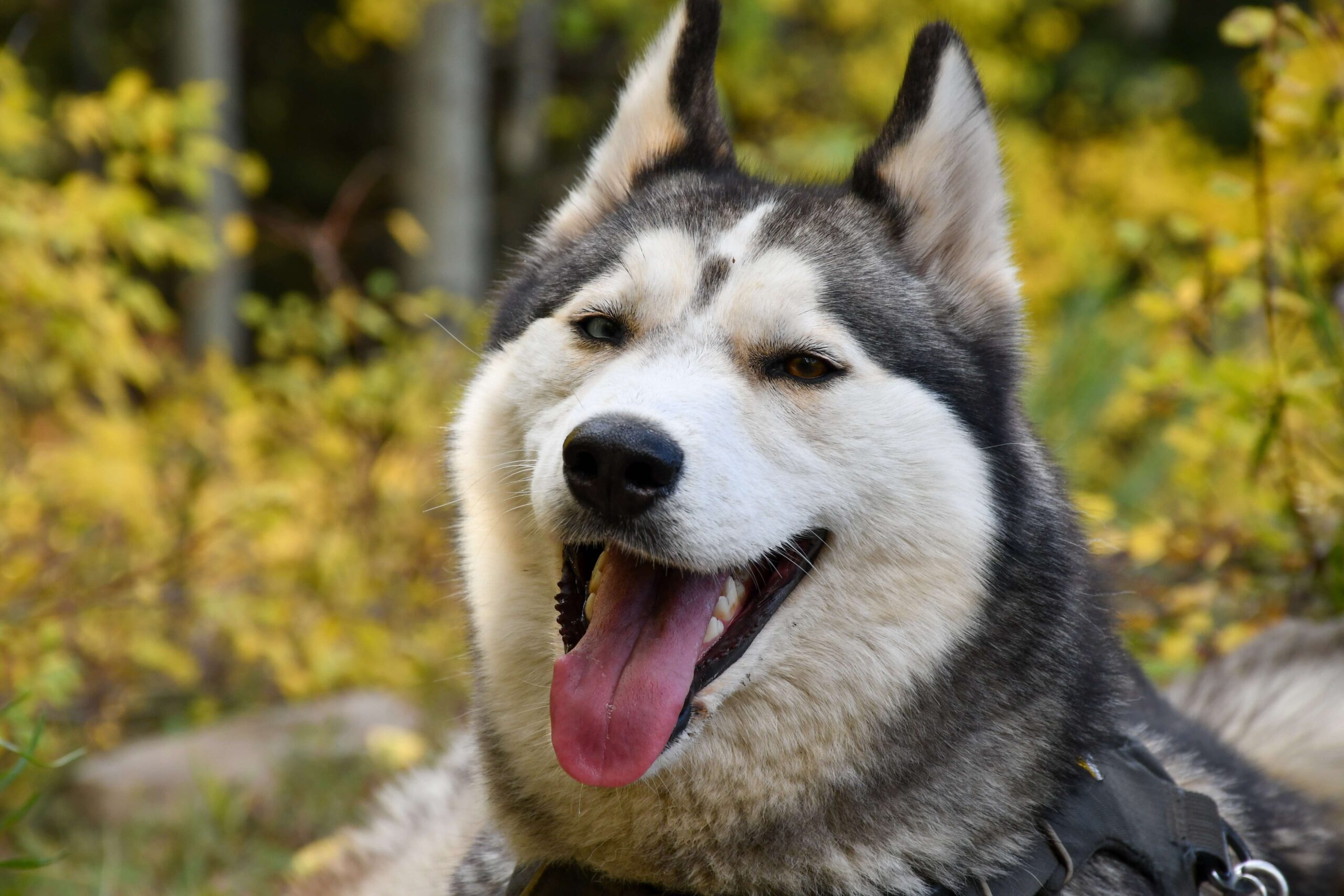
Are dog blankets only for winter?
Just like us, dogs still need a comfortable place to rest all year round and a blanket offers more than just warmth over winter for our furry friends. Did you know that it’s a natural instinct for dogs to ‘nest’, or create their own den, which they can seek shelter under, the same way in which they use a blanket? However, we’ll look more closely into the other benefits of dog blankets below.
What are the benefits of dog blankets?
A great night’s sleep for your dog
Dogs love to snooze, and having a comfortable spot to rest their heads is key to a great night’s sleep. Providing your pup with a cosy blanket for their bed or on top of where your dog sleeps will guarantee the deep, dreamy sleep they deserve, particularly on cold nights!
Can help relieve your dog’s anxiety
Dog blankets can be taken anywhere, meaning that they can be a useful tool for reducing your dog’s anxiety. Giving your dog an item that they associate with their home from the smell and feel of the blanket will provide them with a sense of security in new environments when they feel nervous.
Protects your furniture
As well as dog blankets benefitting your dogs, they can benefit owners, too! Pet blankets can be placed on furniture around the home where your dog usually relaxes, meaning that your couch or bed can be protected from muddy paws and fur.
Keeps your home looking stylish
Dog blankets can also add a stylish look to your home! The stylish design of the Omlet Luxury Faux Sheepskin Dog Blanket is perfect for complementing any home decor!
Comfort is key for our beloved dogs, and we only want the best for our pets. So now we know why dog blankets are so important to our furry friends, who wouldn’t want one?

This entry was posted in Dogs















































